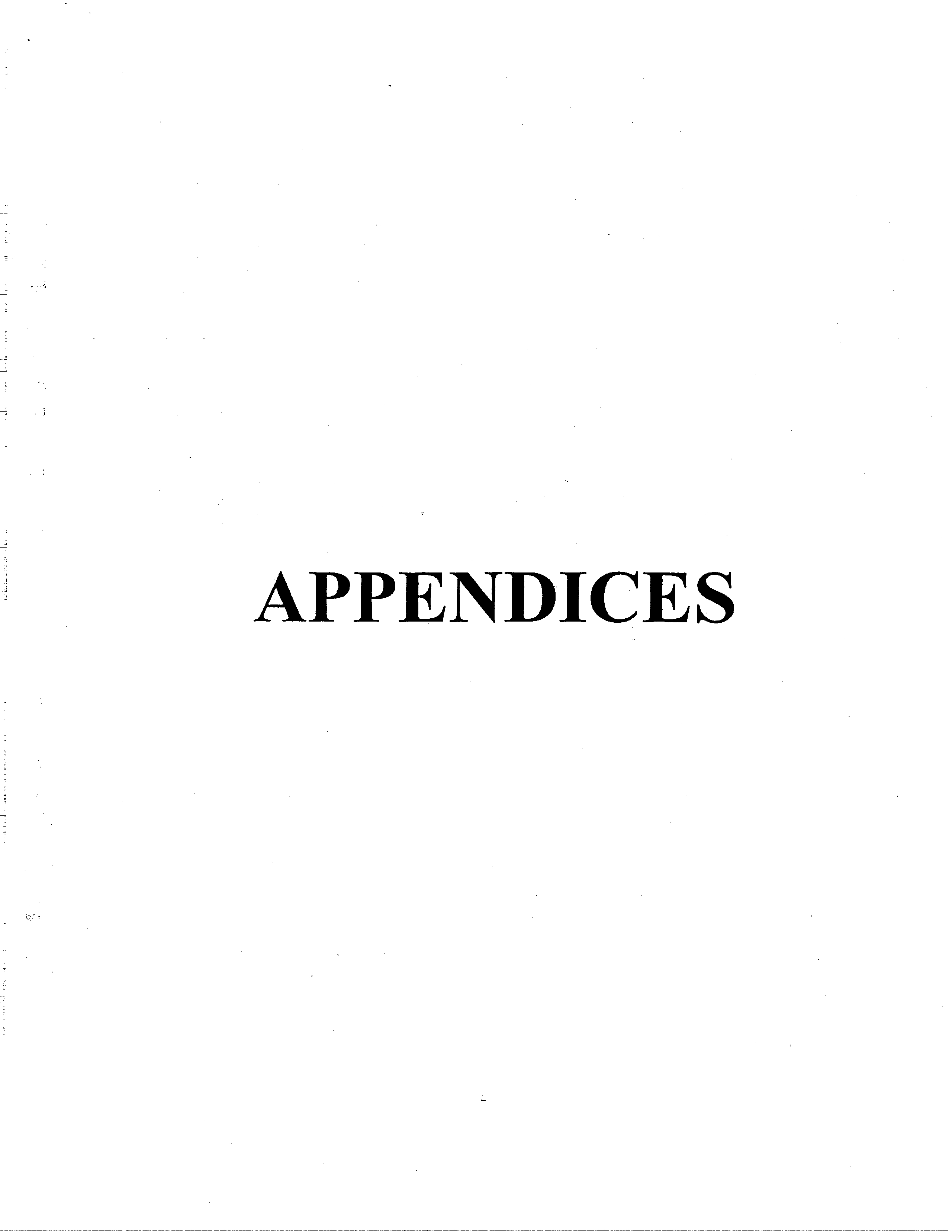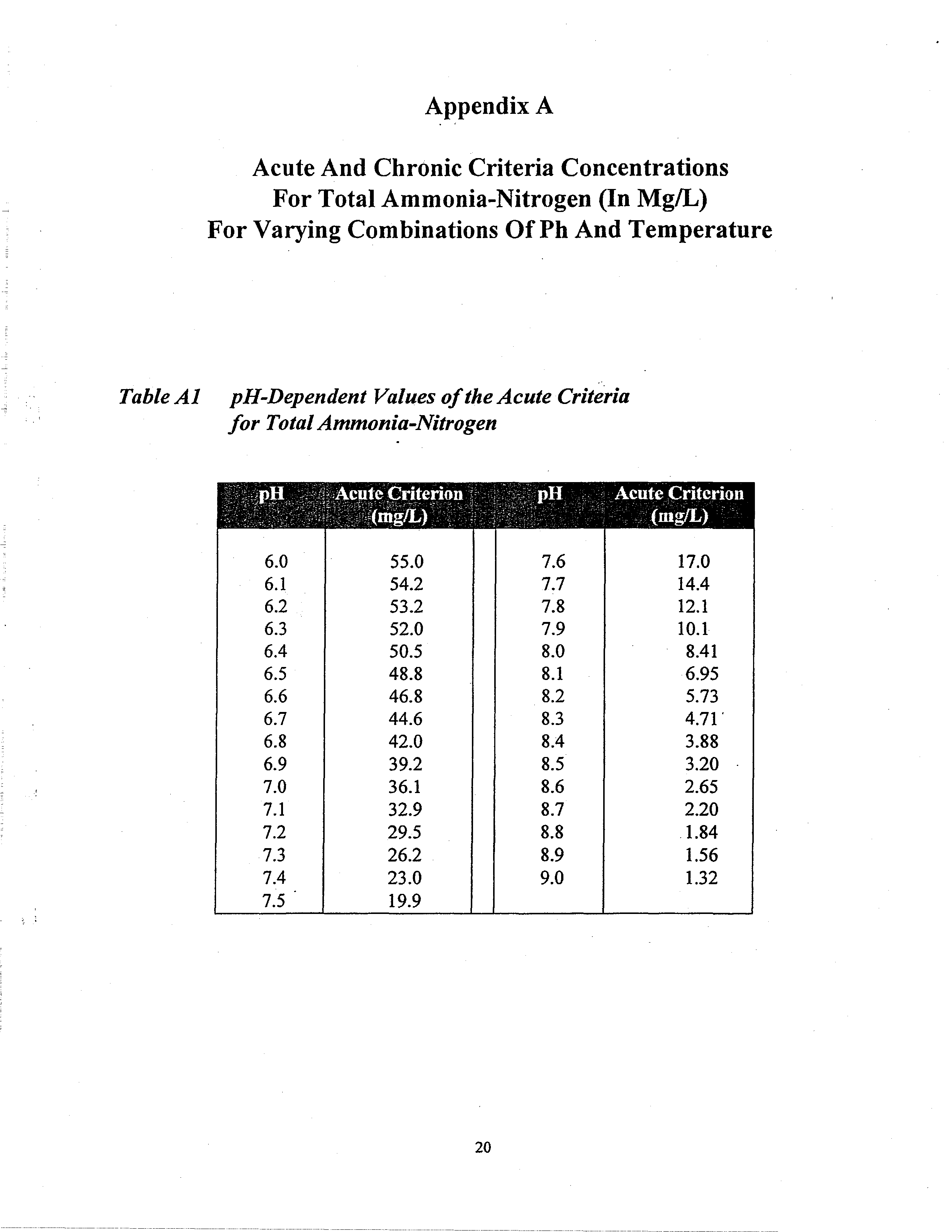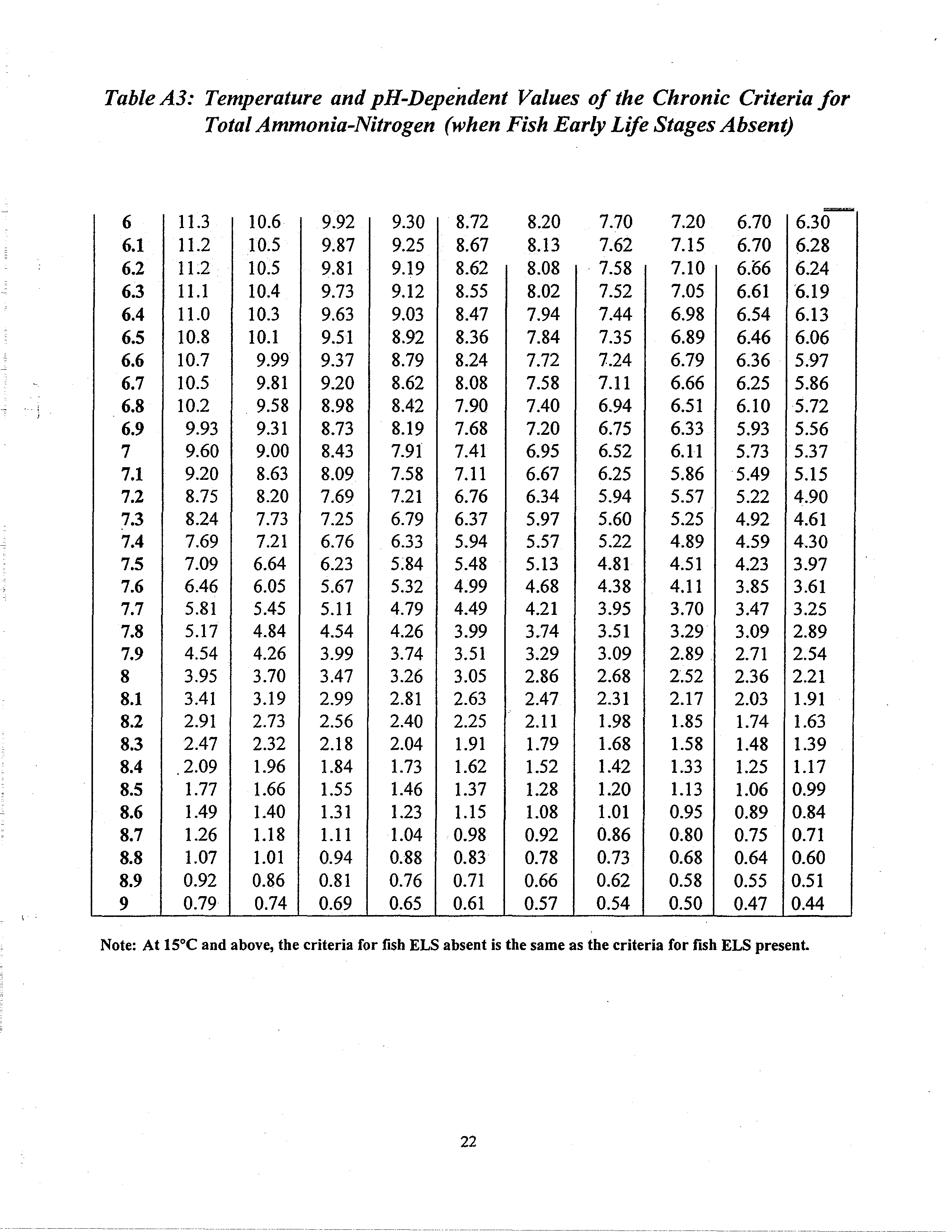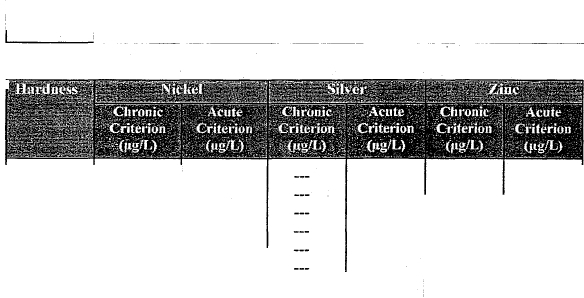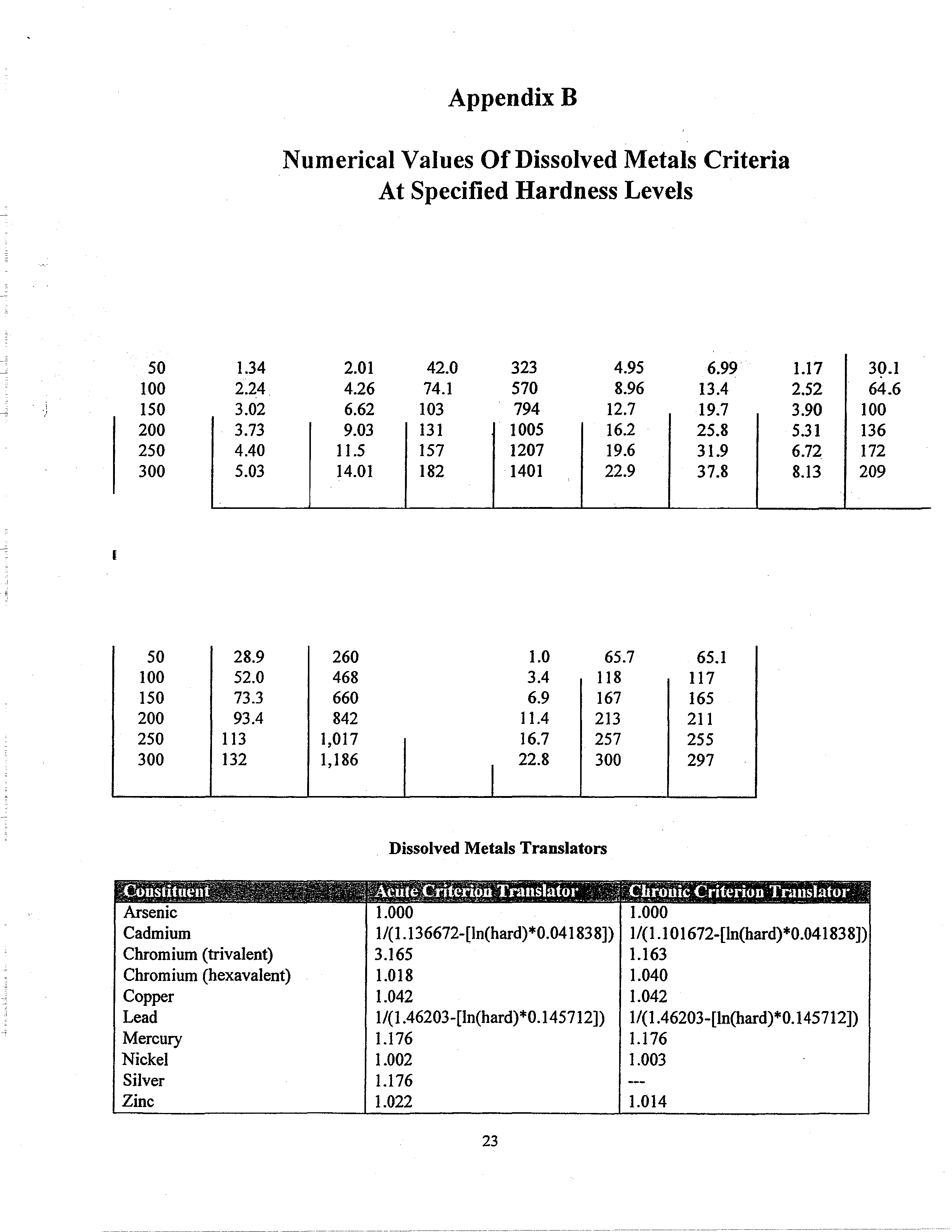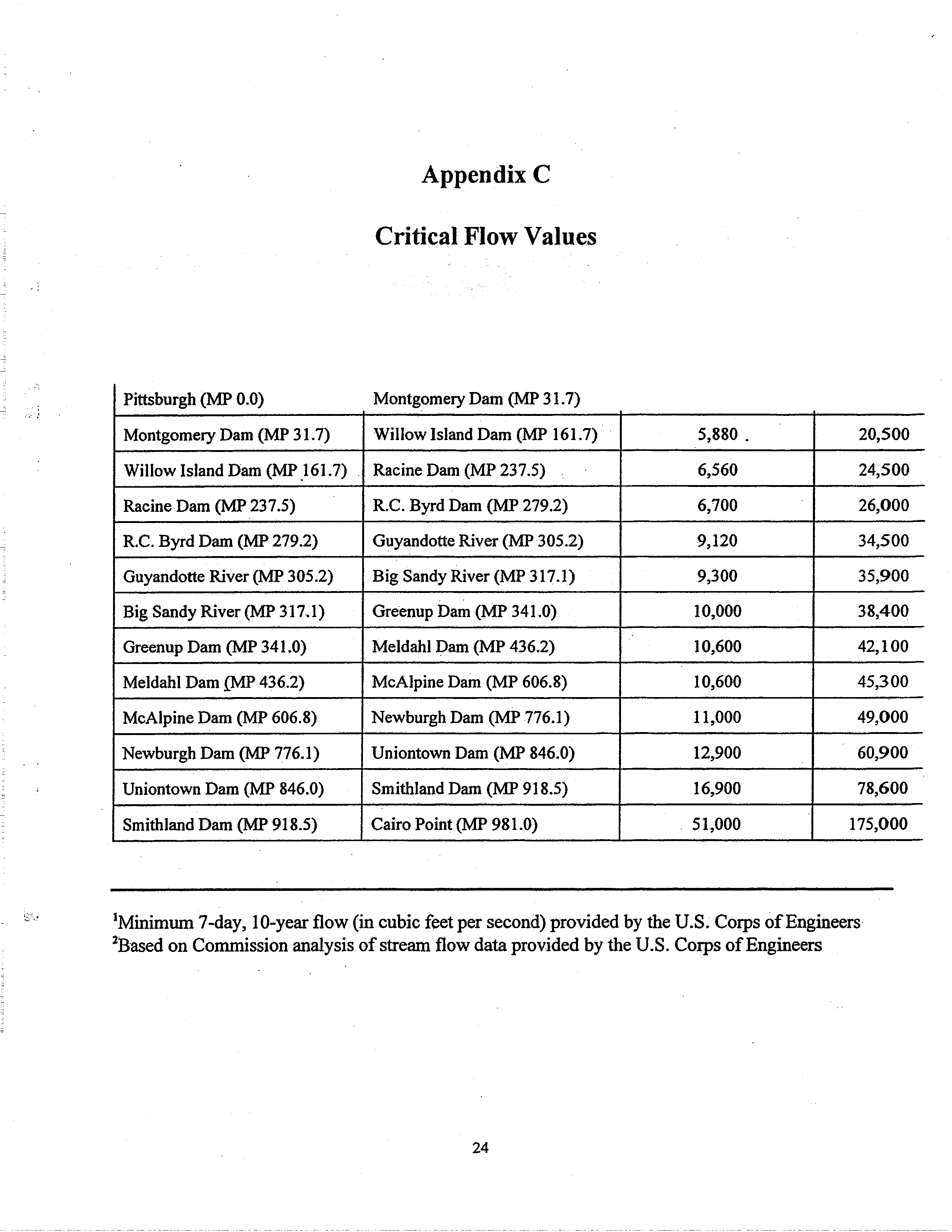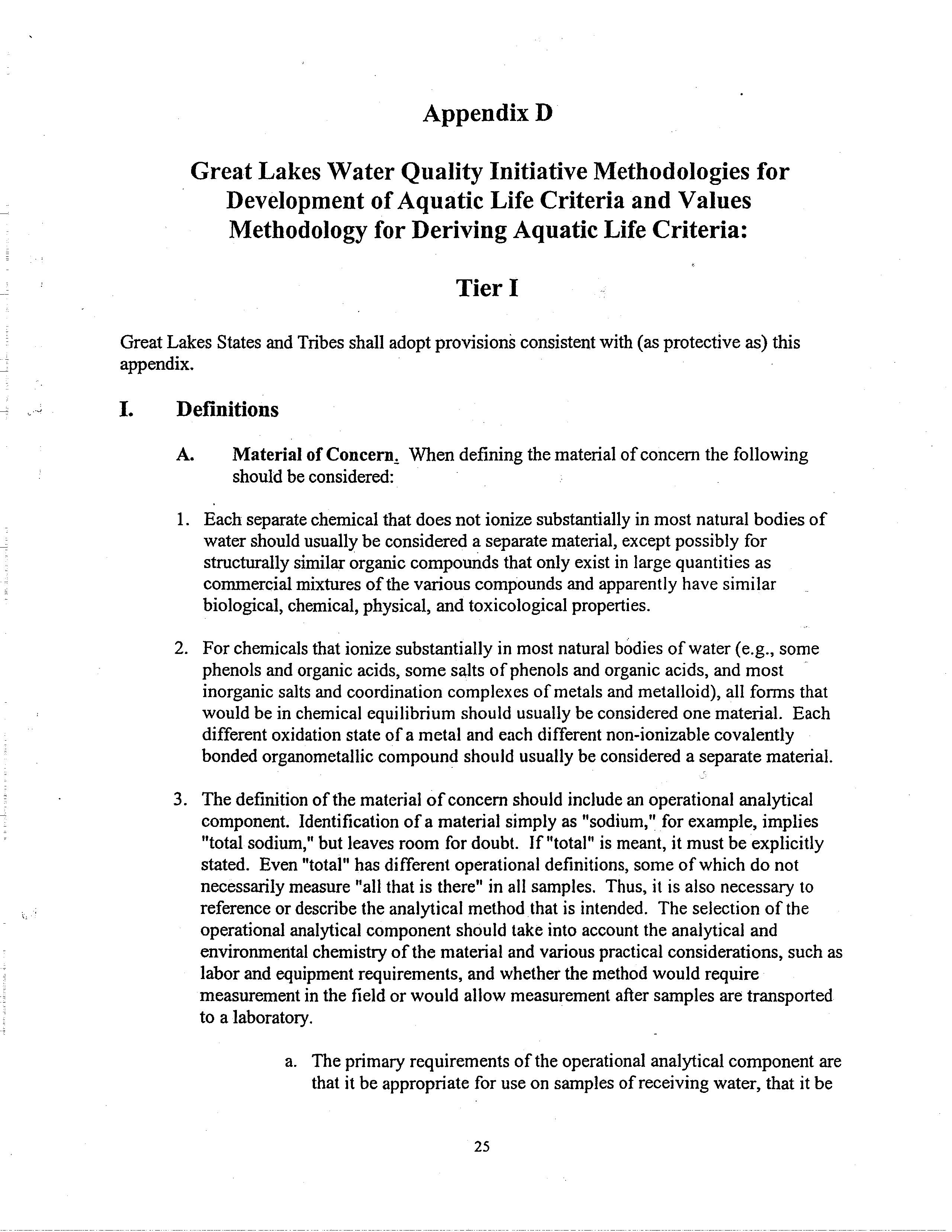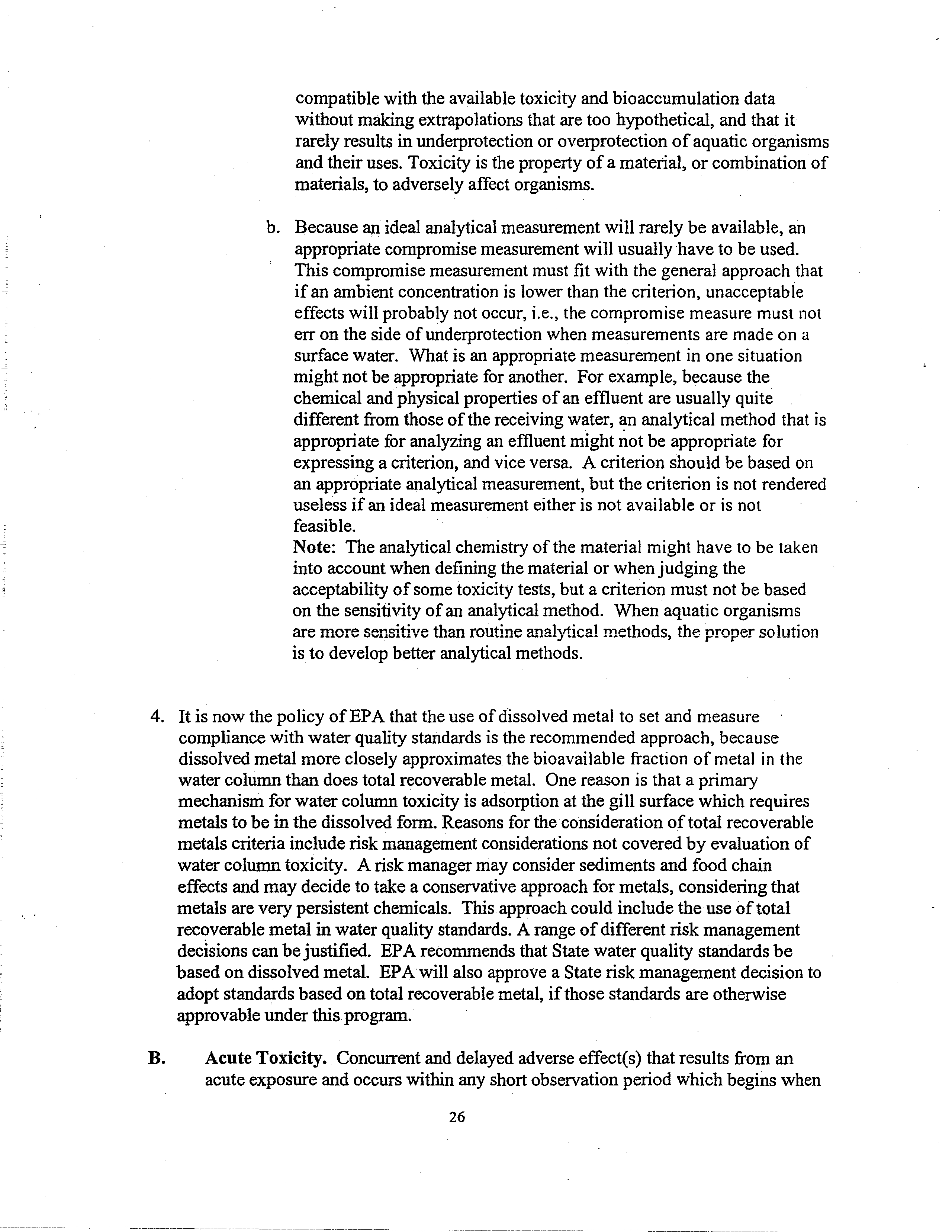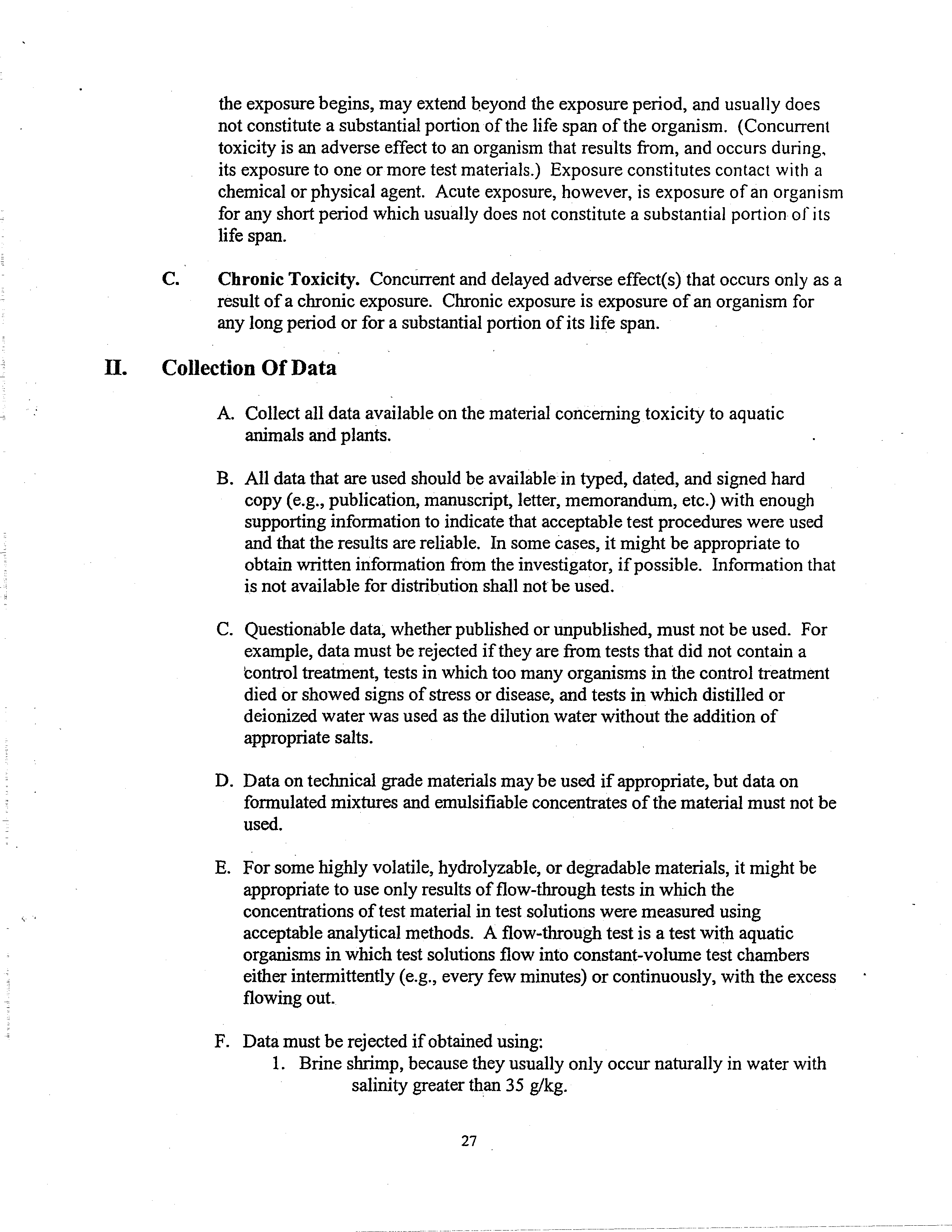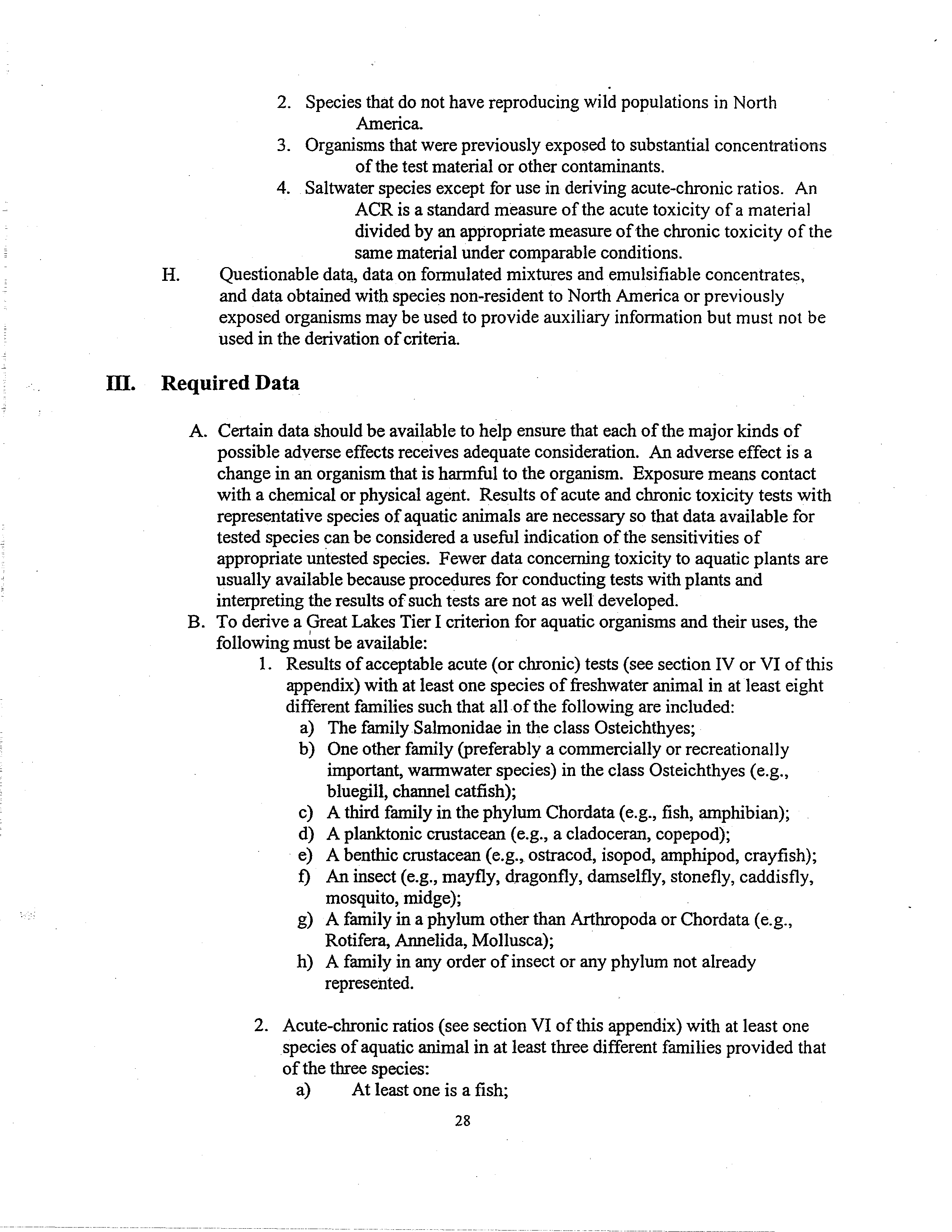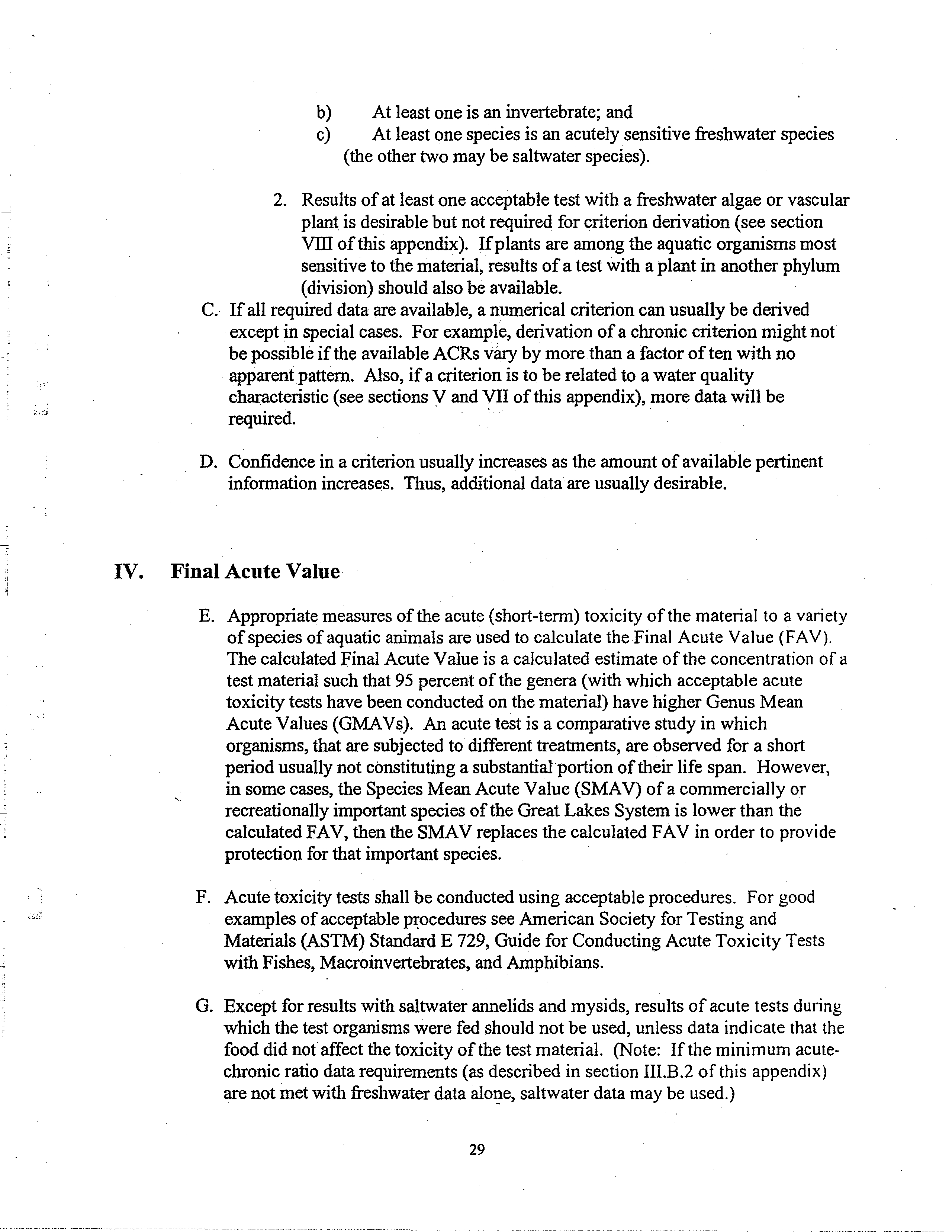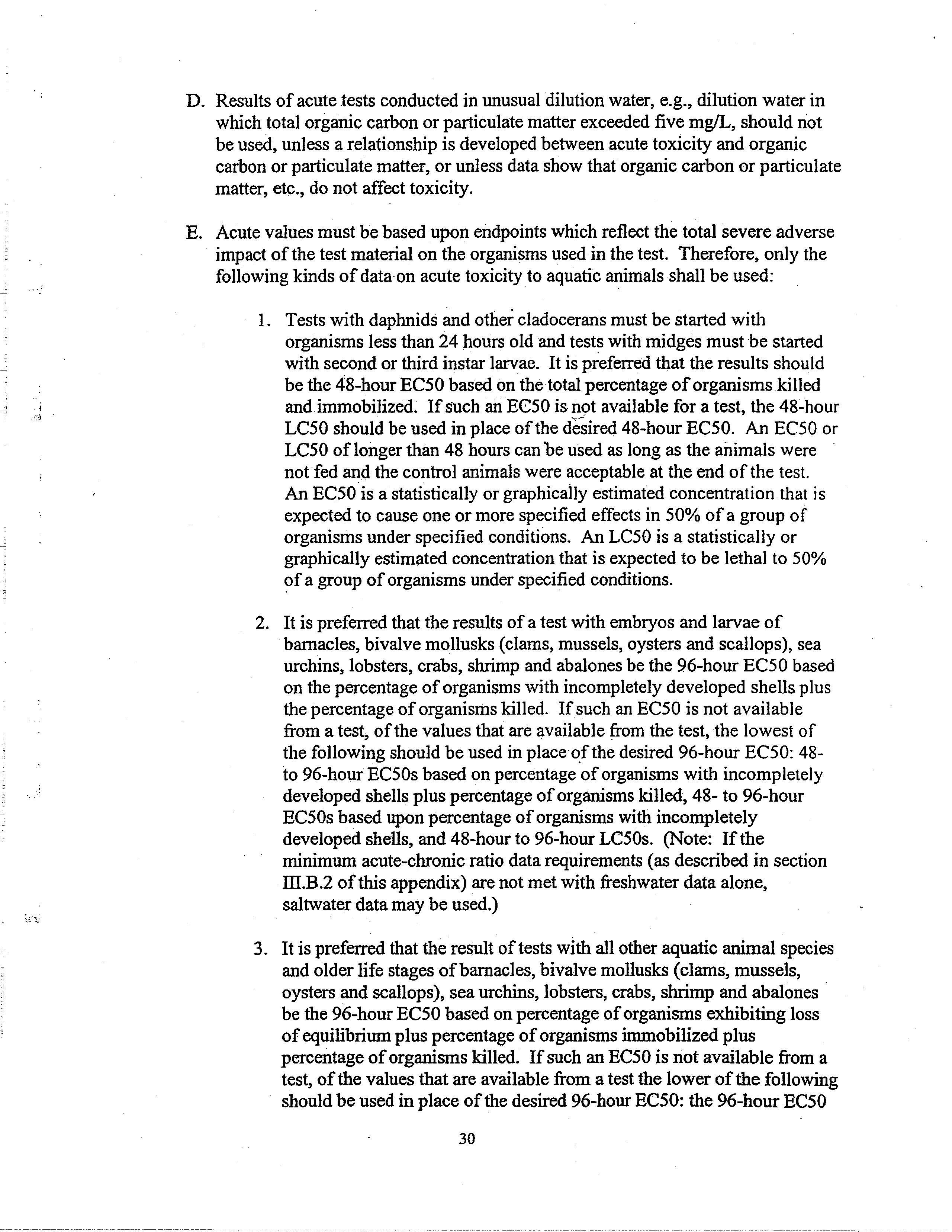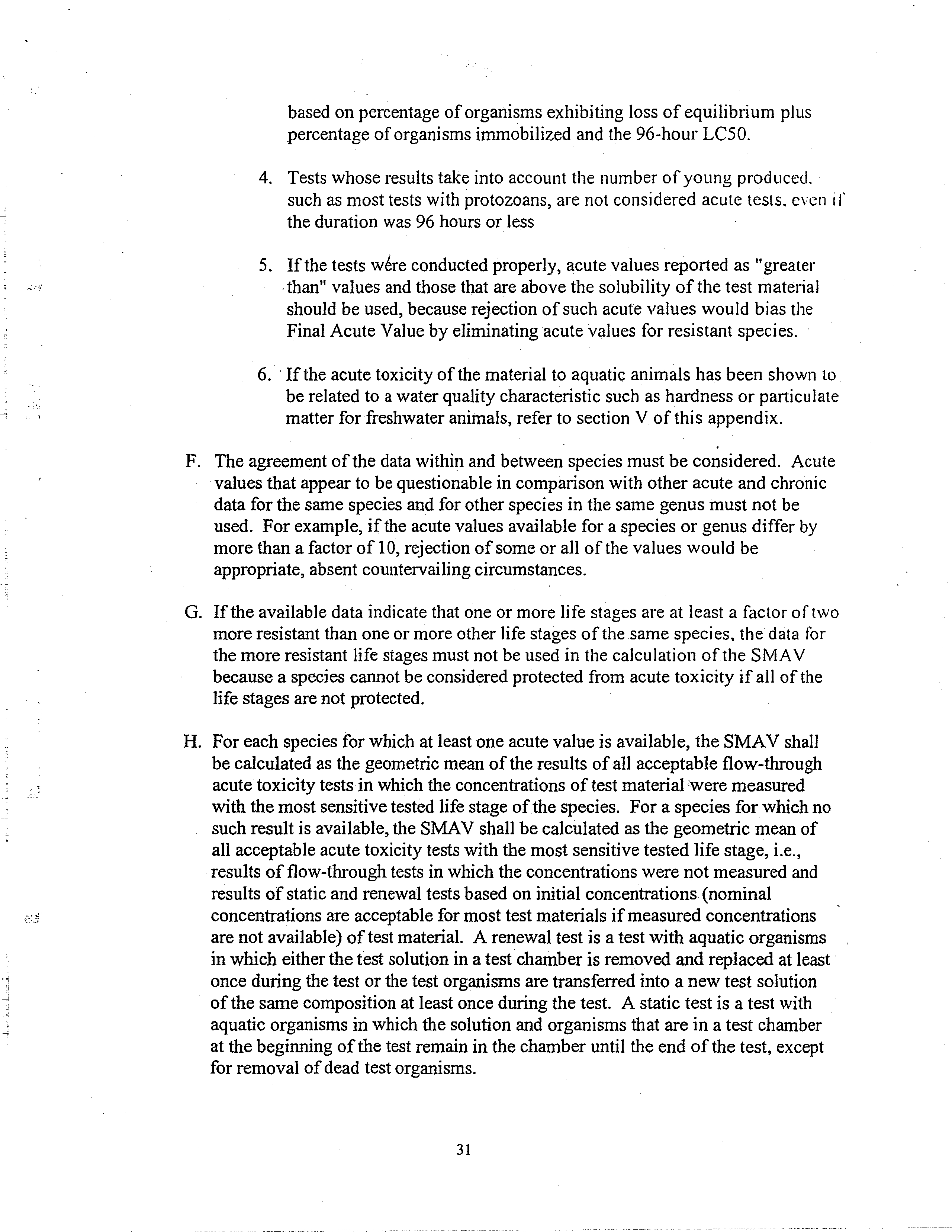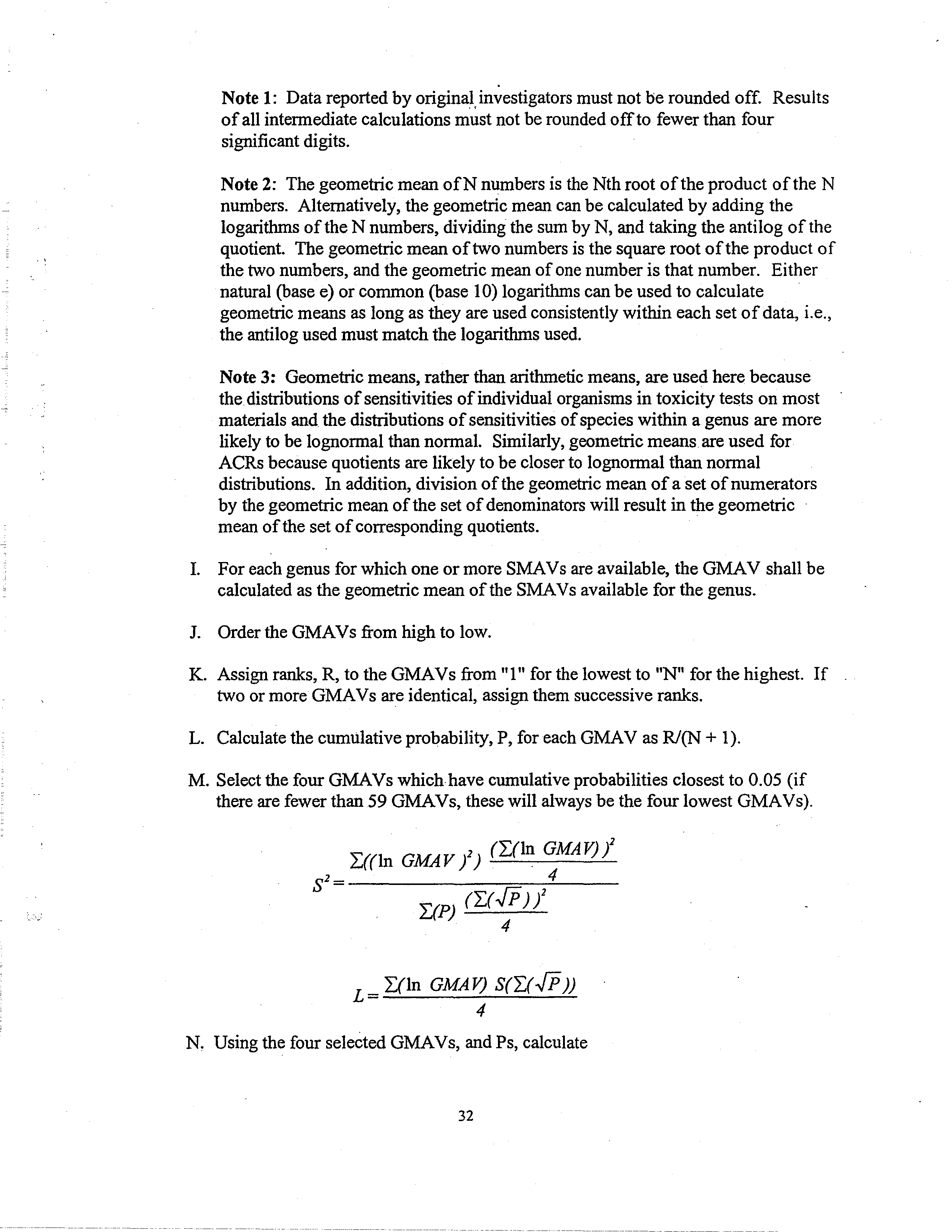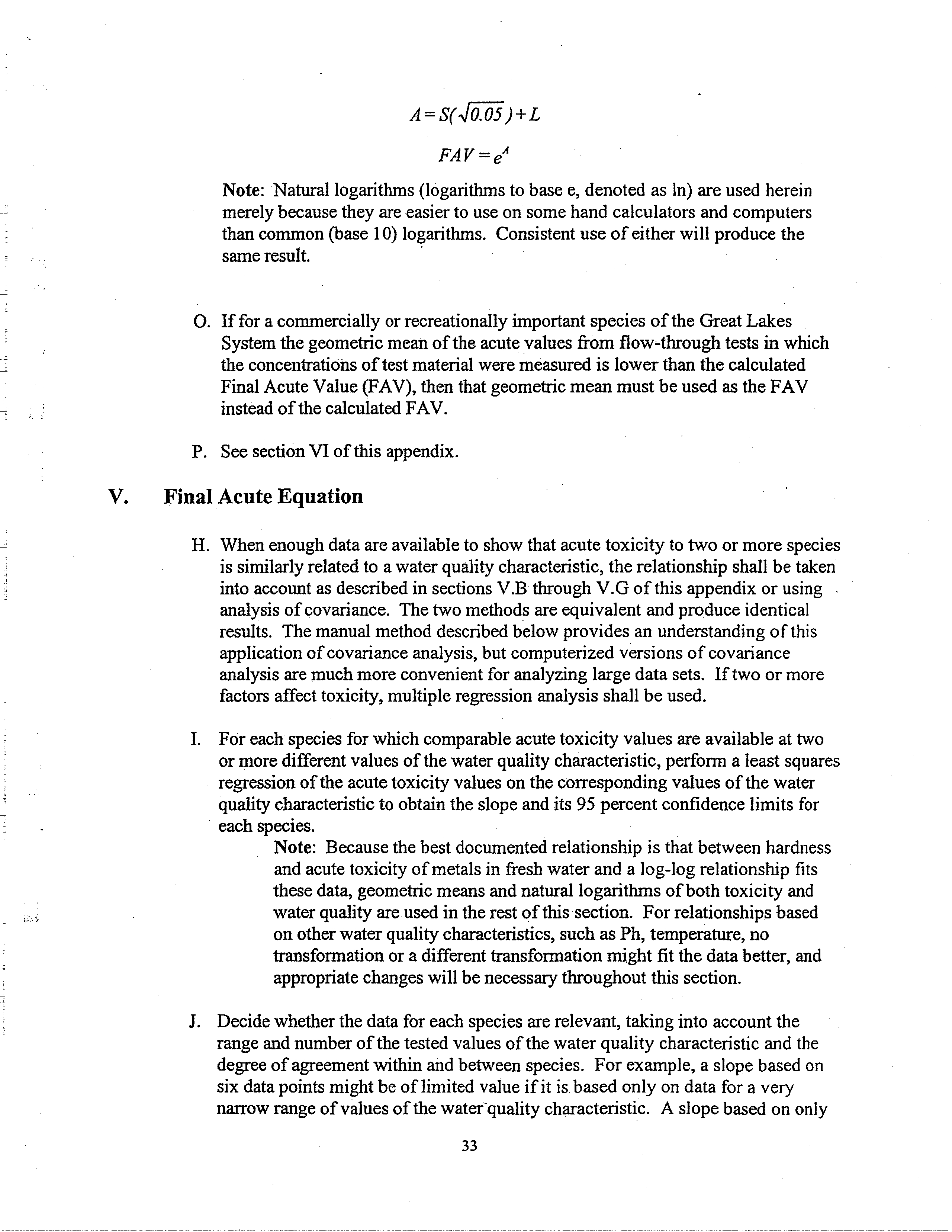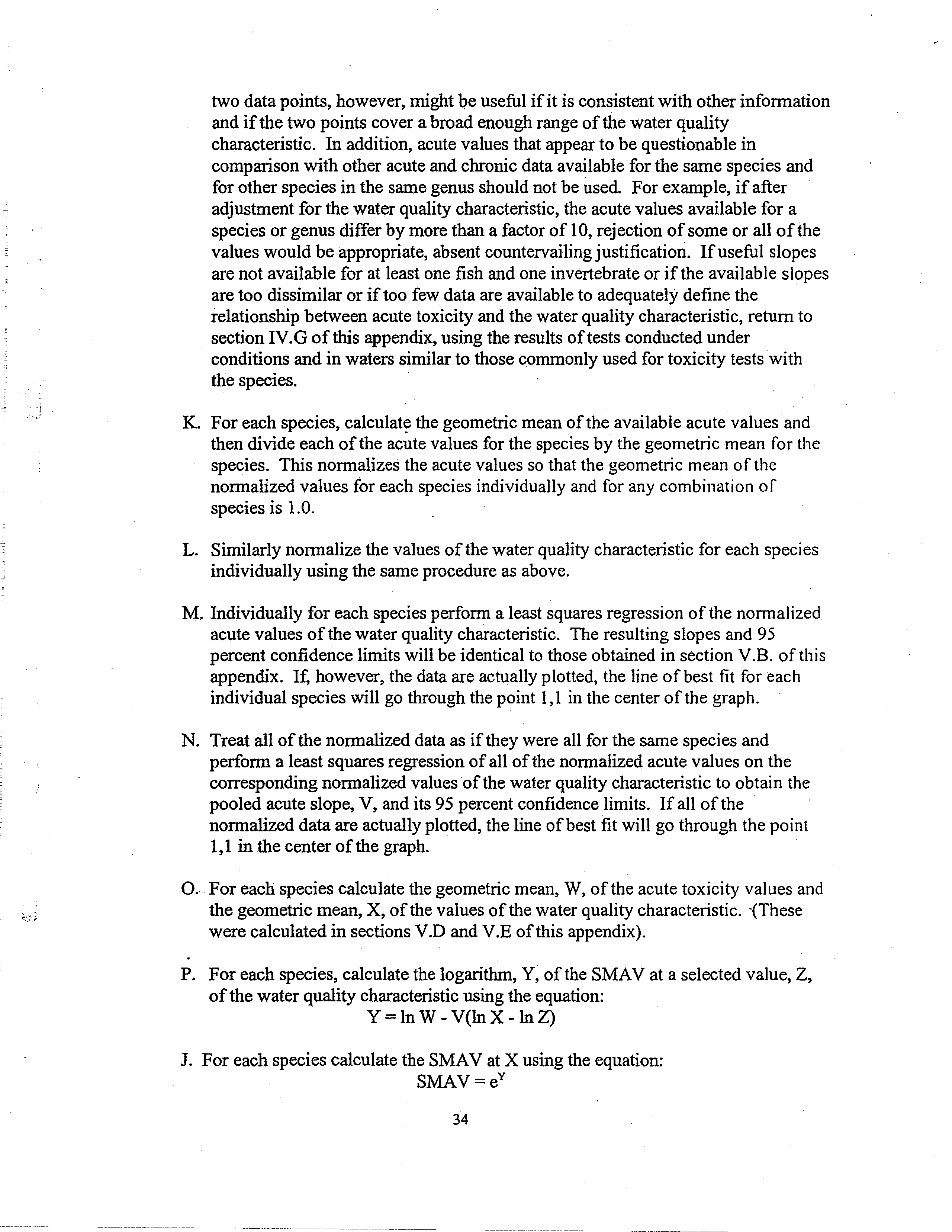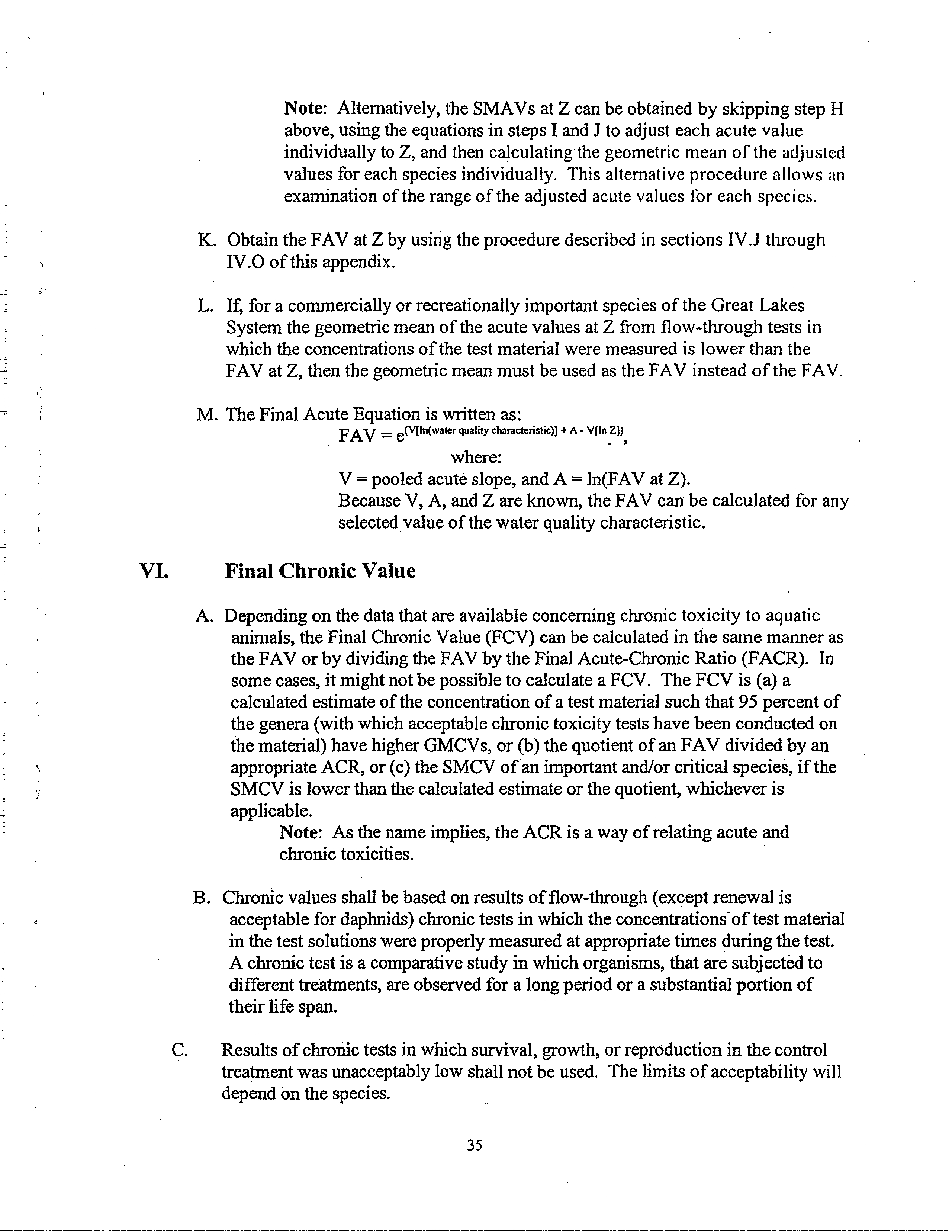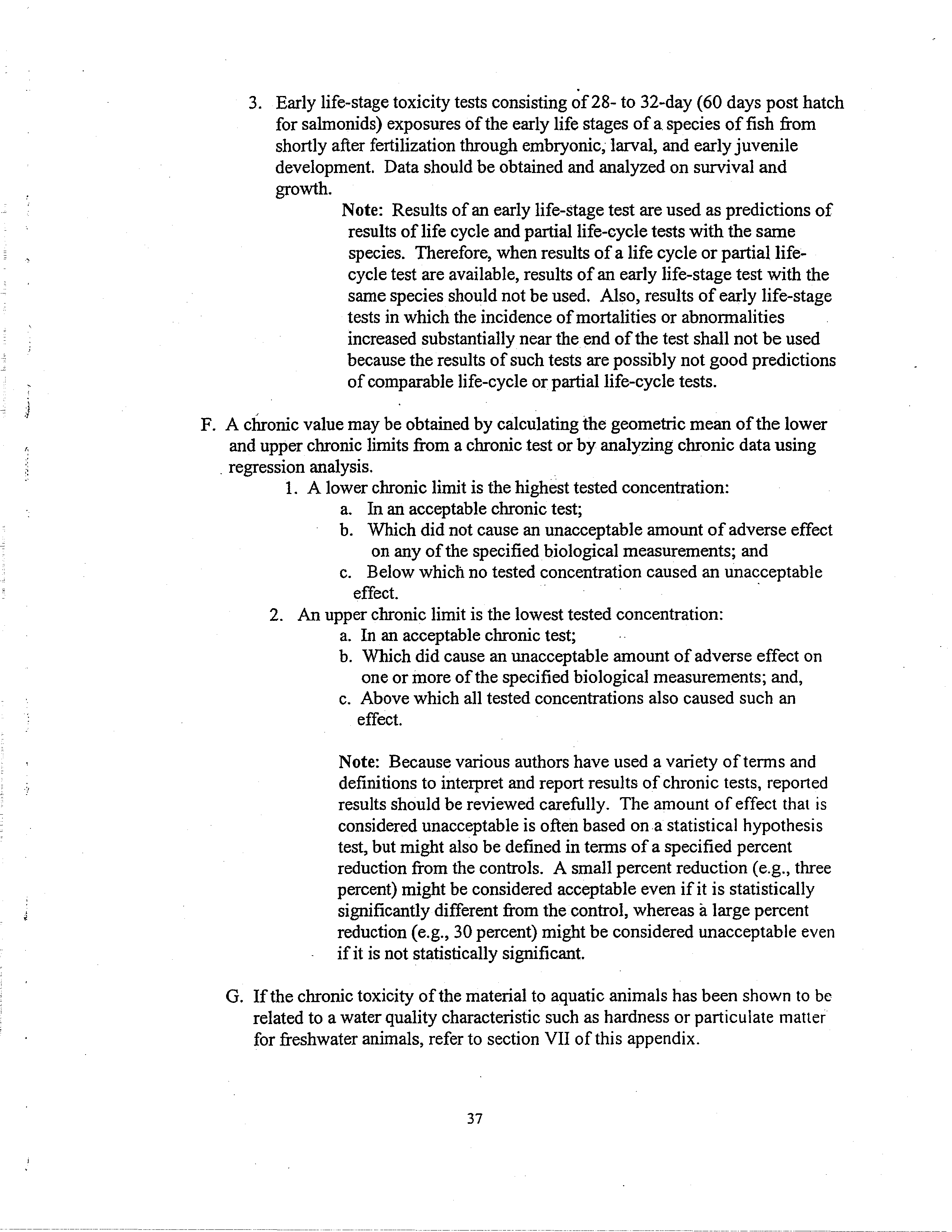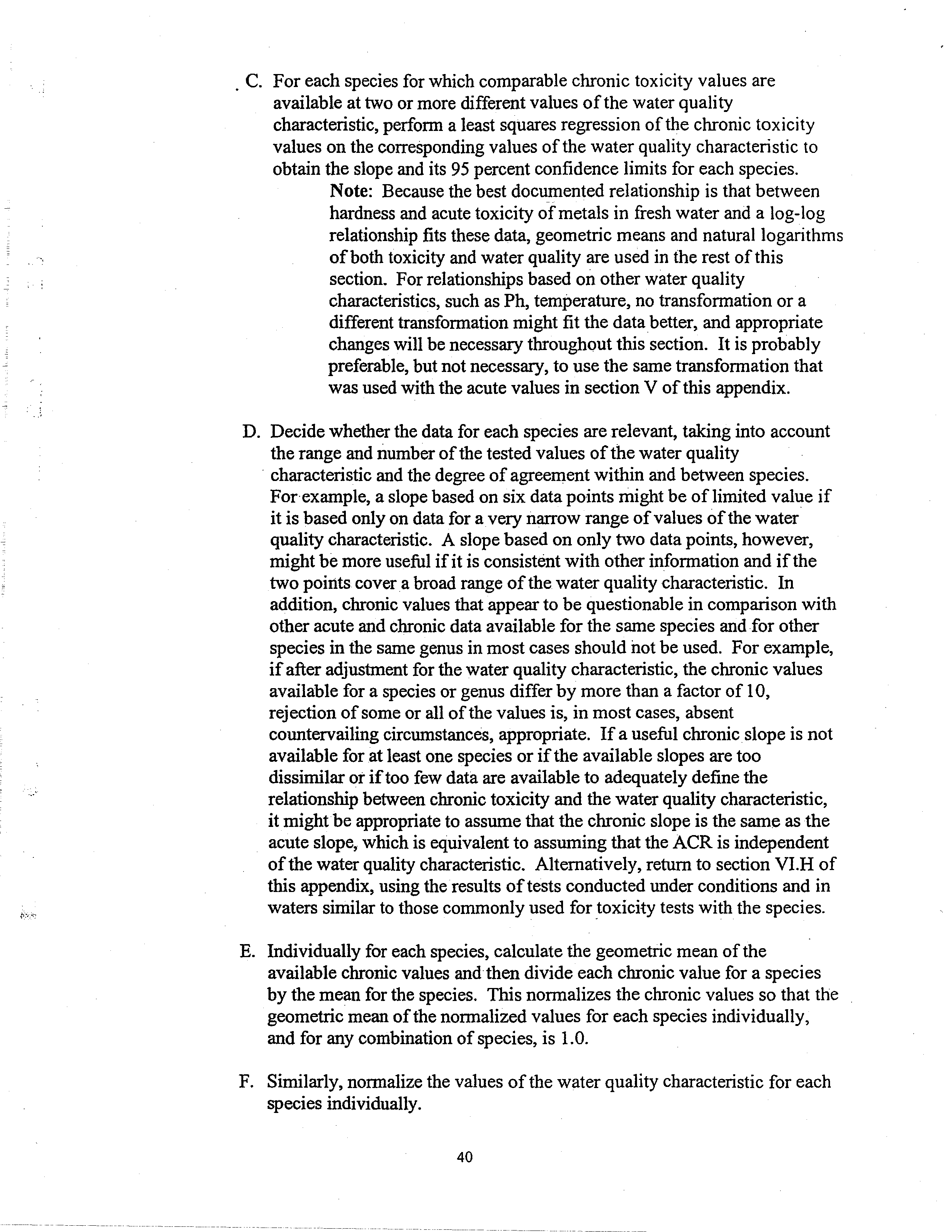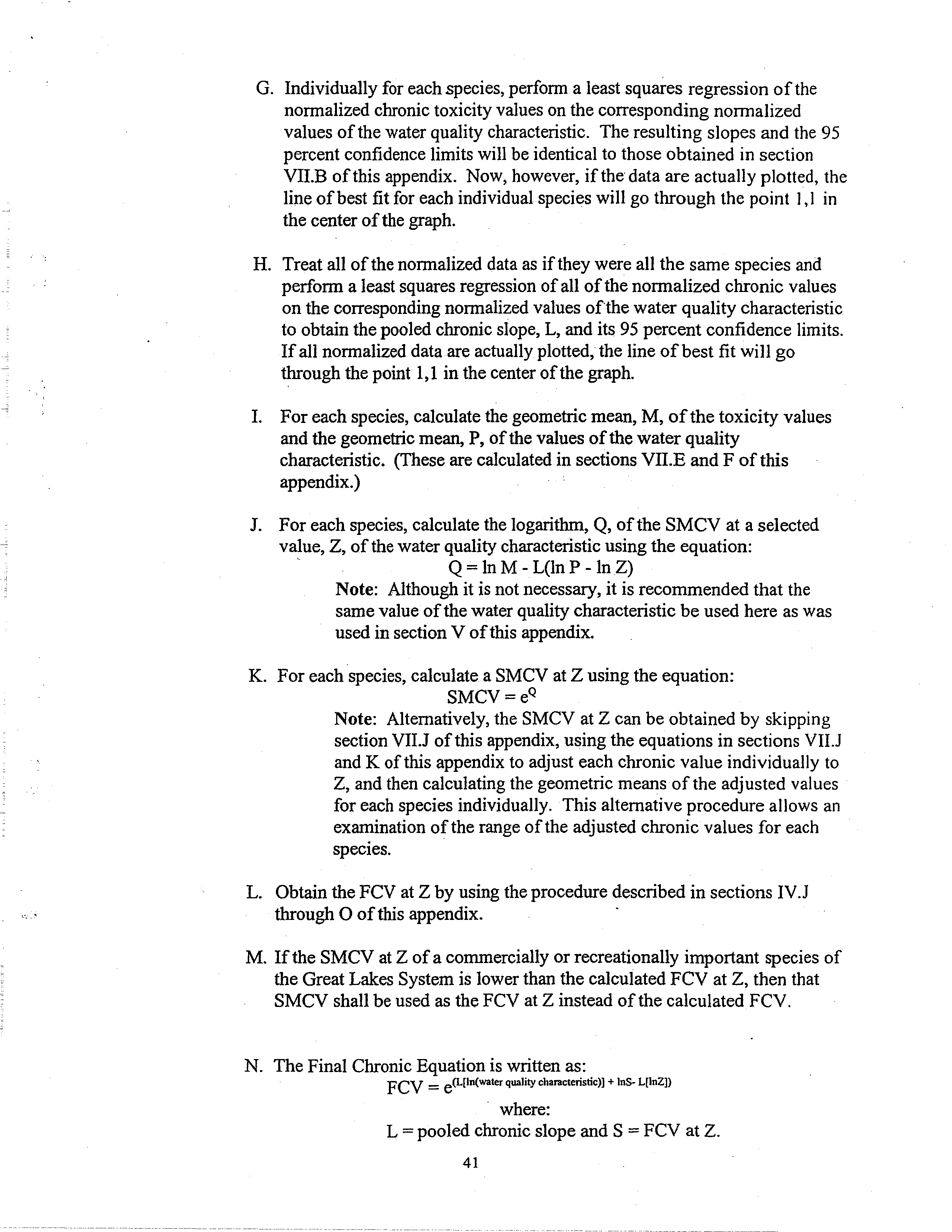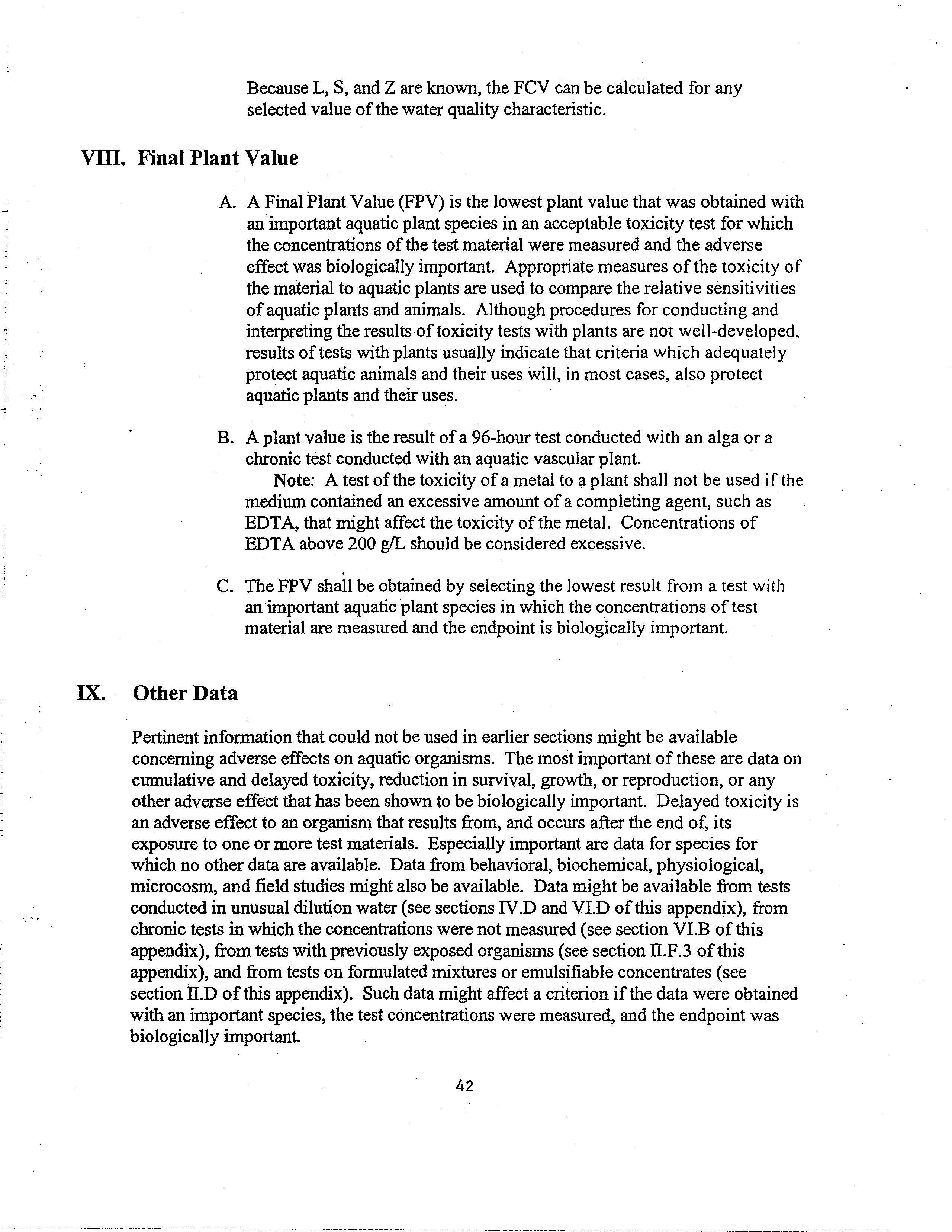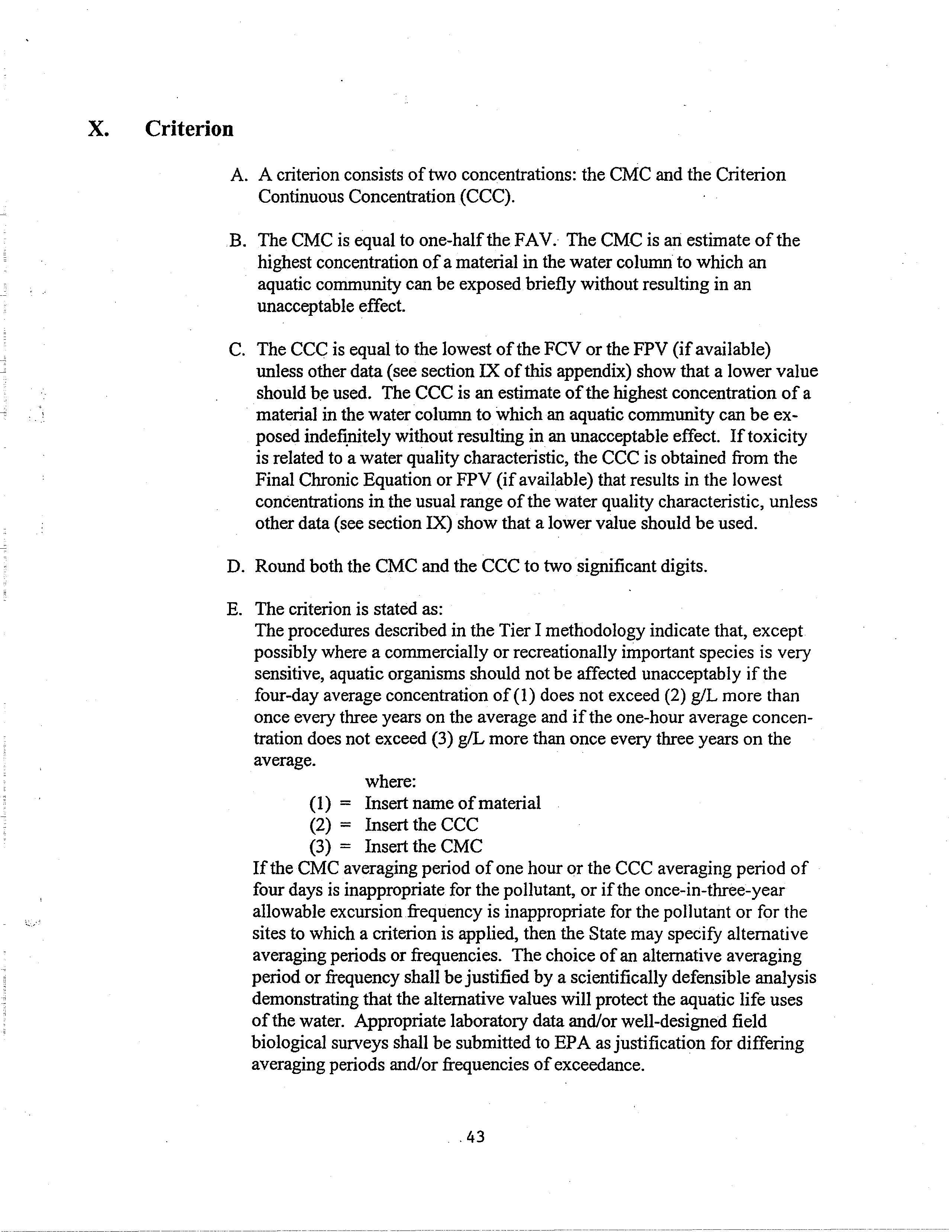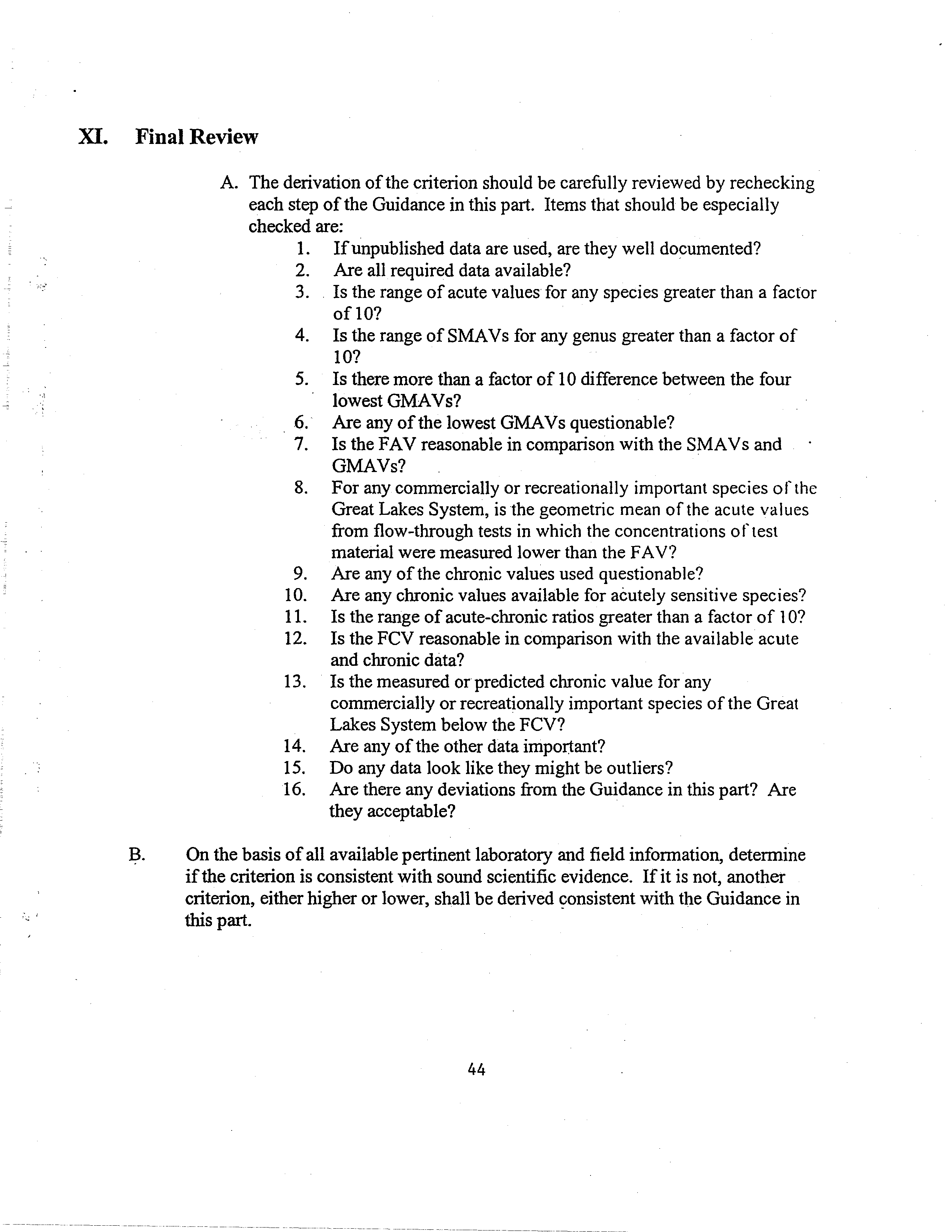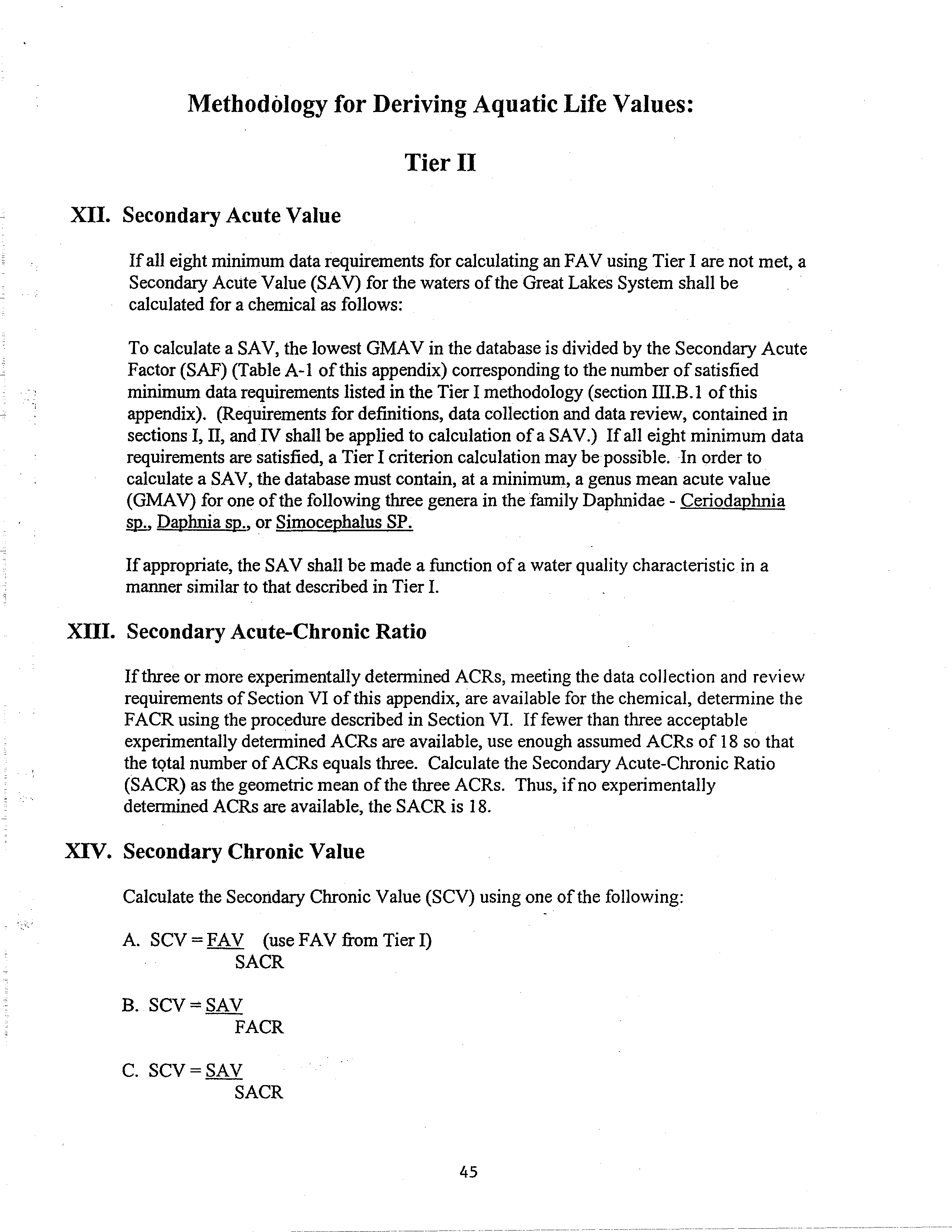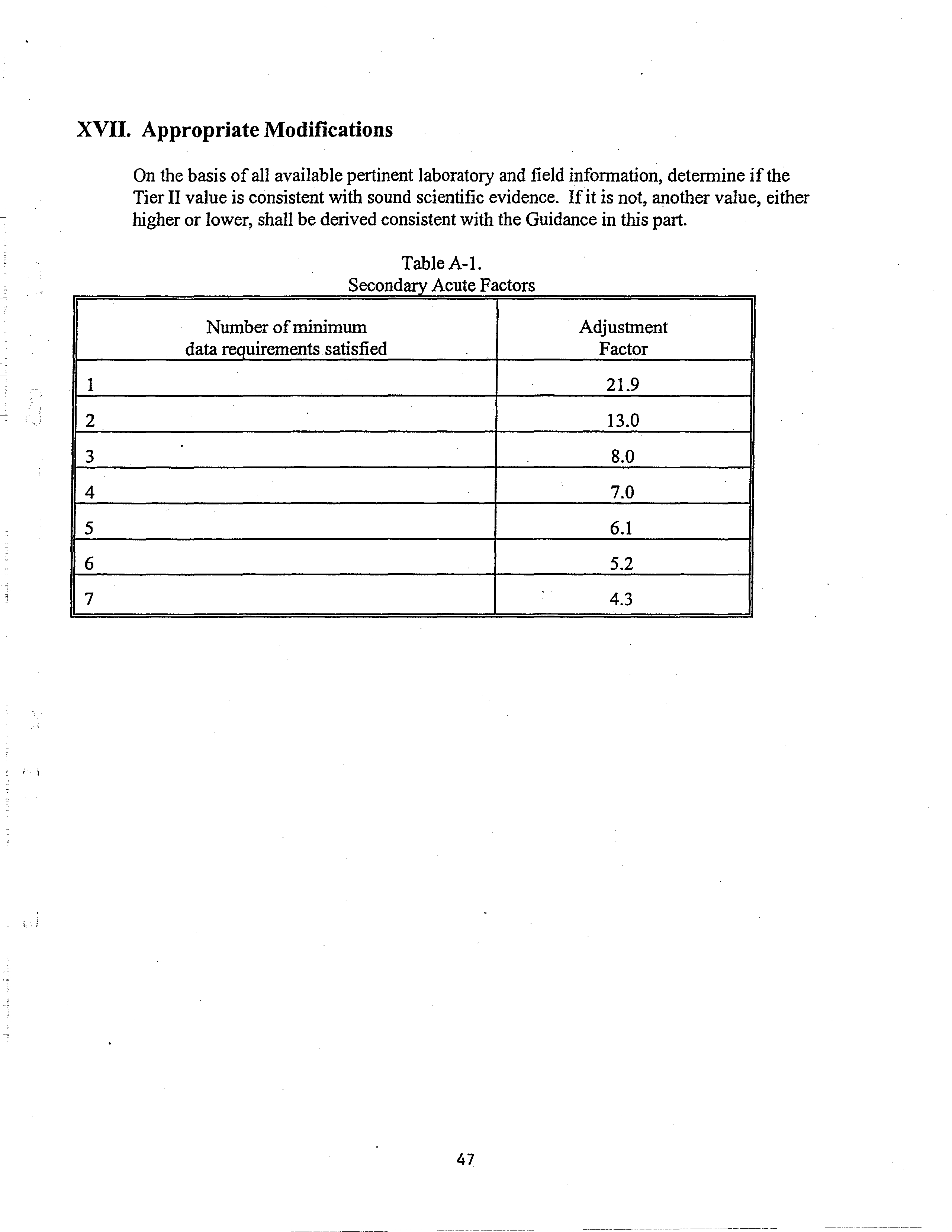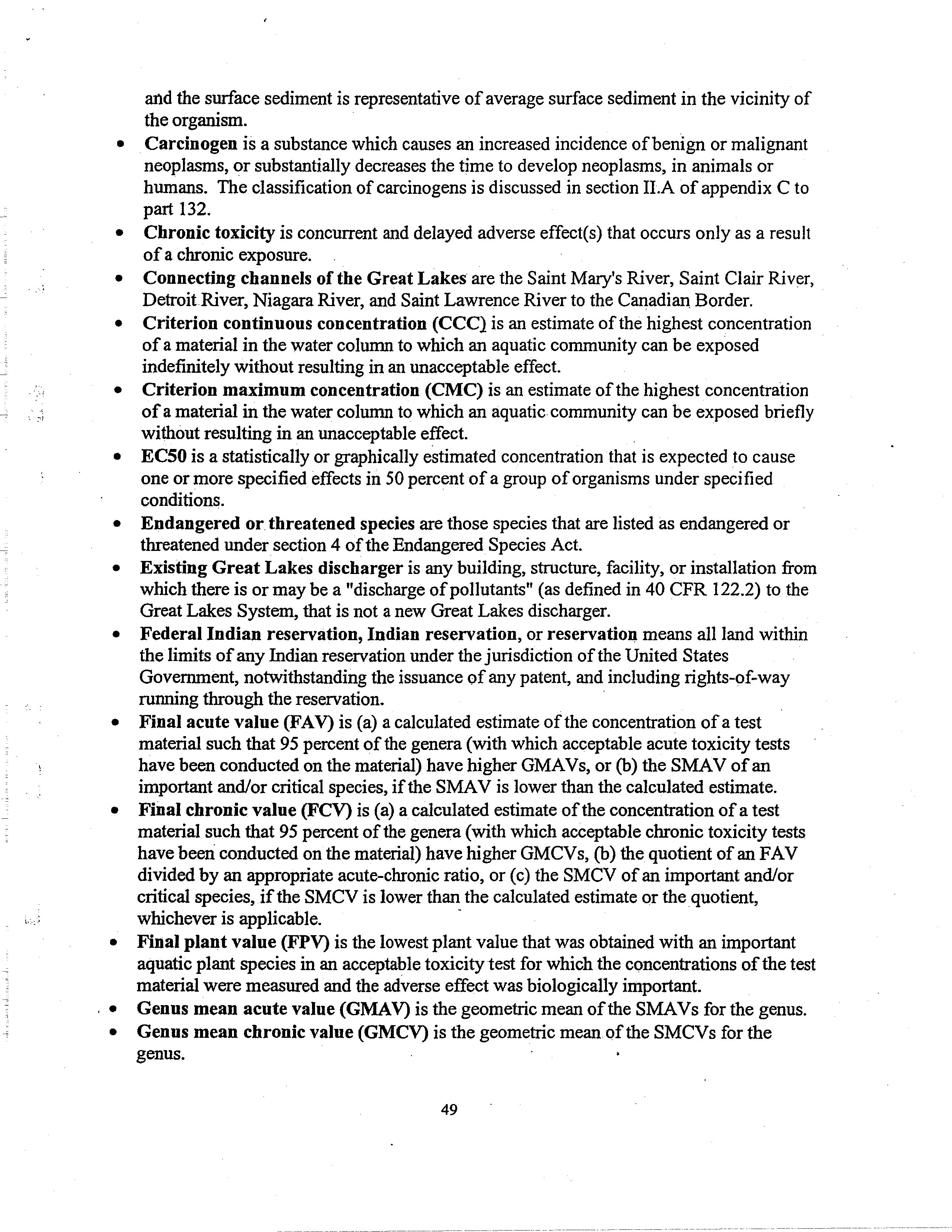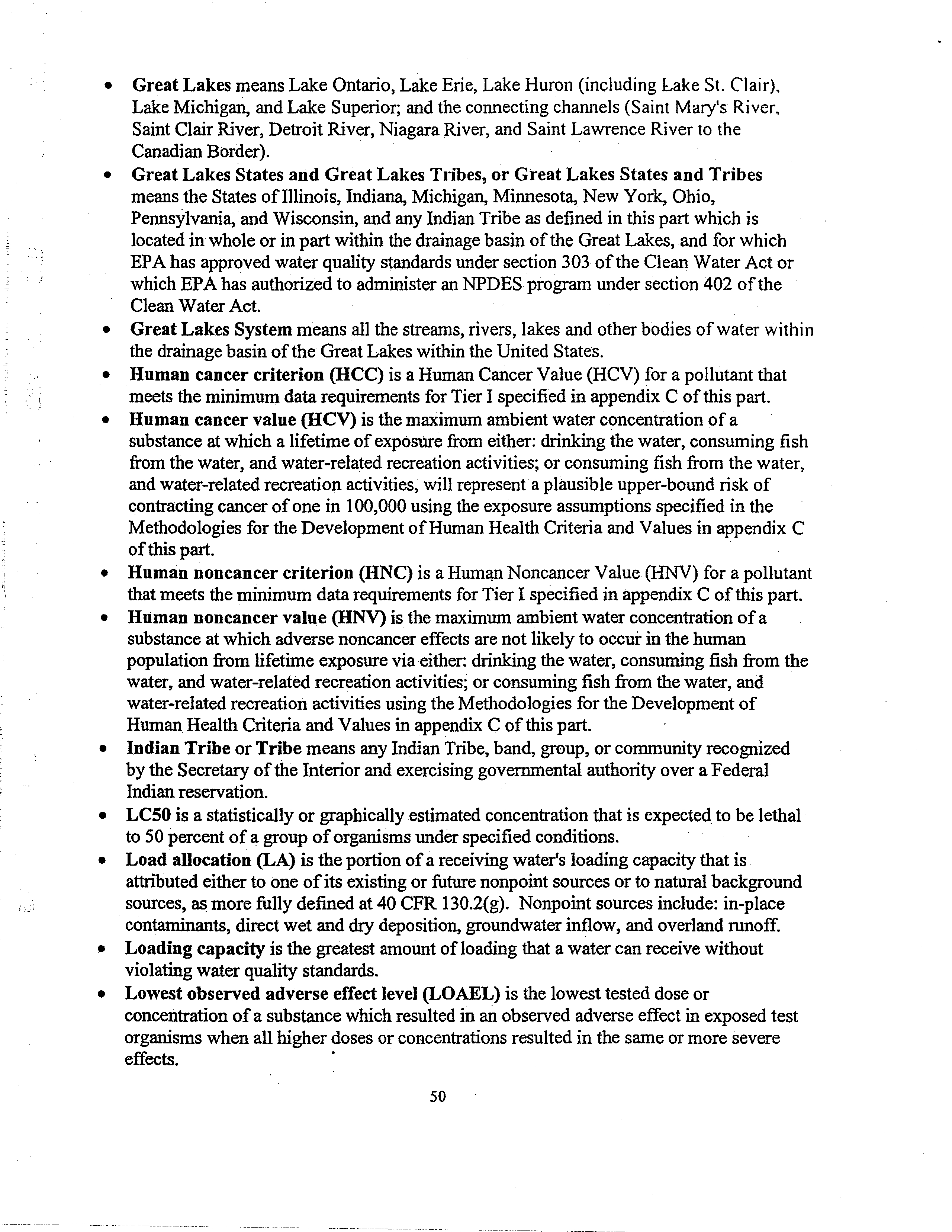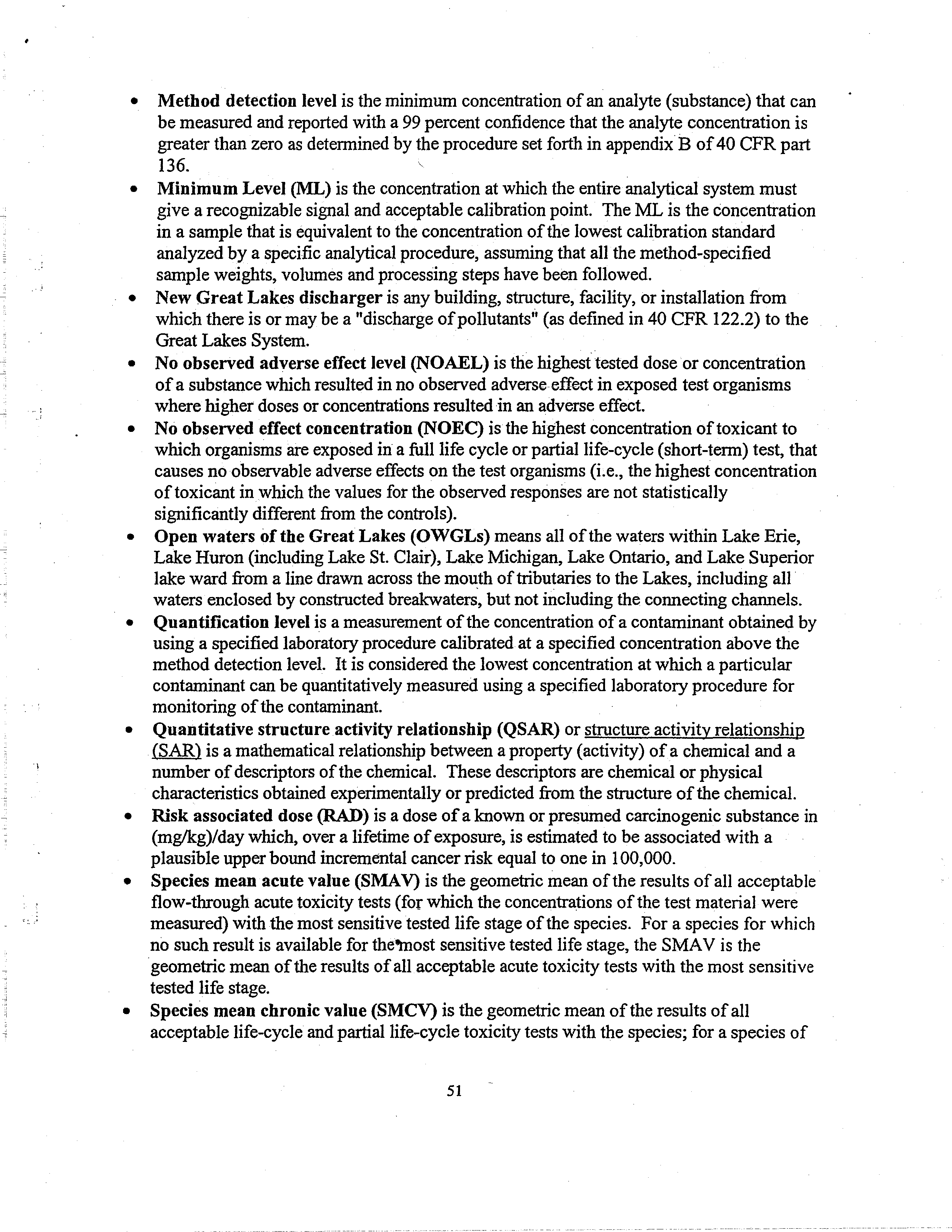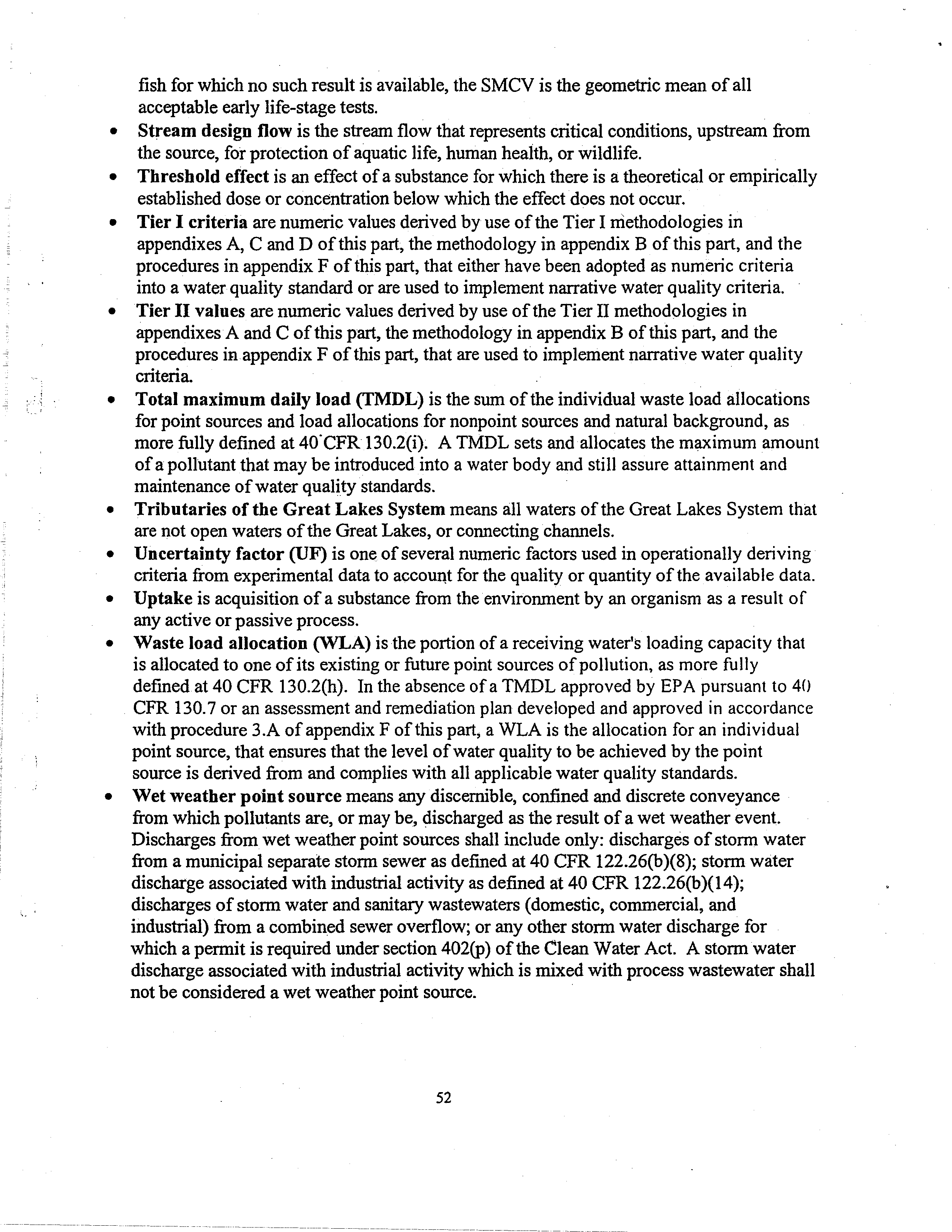APPENDICES
Appendix A
Acute And Chronic
Criteria Concentrations
For Total Ammonia-Nitrogen (In Mg/L)
For Varying
Combinations Of Ph And Temperature
Table Al
pH-Dependent Values oftheAcute Criteria
for Total Ammonia-Nitrogen
pH
Acute Criterion
pH
Acute Criterion
(mg/L)
(mgIL)
6.0
55.0
7.6
17.0
6.1
54.2
7.7
14.4
6.2
53.2
7.8
12.1
6.3
52.0
7.9
10.1
6.4
50.5
8.0
‘
8.41
6.5
48.8
8.1
6.95
6.6
46.8
8.2
5.73
6.7
44.6
8.3
4.71
6.8
42.0
8.4
3.88
6.9
39.2
8.5
3.20
7.0
36.1
8.6
2.65
7.1
32.9
8.7
2.20
7.2
29.5
8.8
1.84
7.3
26.2
8.9
1.56
7.4
23.0
9.0
1.32
7.5
19.9
20
Table A2:
Temperature andpH-Dependent Values of the Chronic Criteriafor
TotalAmmonia-Nitrogen
(when Fish Early
L~fe
Stages Present
-
March 1
-
October 31)
6
6.1
6.2
6.3
6.4
6.5
6.6
6.7
6.8
6.9
7
7.1
7.2
7.3
7.4
7.5
7.6
7.7
7.8
7.9
8
8.1
8.2
8.3
8.4
8.5
8.6
8.7
8.8
8.9
9
6.91
6.87
6.82
6.75
6.67
6.57
6.44
6.29
6.12
5.91
5.67
5.39
5.08
4.73
4.36
3.98
3.58
3.18
2.80
2.43
2.10
1.79
1.52
1.29
1.09
0.92
0.78
0.66
0.56
0.49
6.91
6.87
6.82
6.75
6.67
6.57
6.44
6.29
6.12
5.91
5.67
5.39
5.08
4.73
4.36
3.98
3.58
3.18
2.80
2.43
2.10
1.79
1.52
1.29
1.09
0.92
0.78
0.66
0.56
0.49
6.28
6.24
6.19
6.13
6.06
5.97
5.86
5.72
5.56
5.37
5.15
4.90
4.61
4.30
3.97
3.61
3.25
2.89
2.54
2.21
1.91
1.63
1.39
1.17
0.99
0.84
0.71
0.60
0.51
0.44
5.52
5.49
5.45
5.39
5.33
5.25
5.15
5.03
4.89
4.72
4.53
4.31
4.06
3.78
3.49
3.18
2.86
2.54
2.24
1.94
1.68
1.43
1.22
1.03
0.87
0.73
0.62
0.53
0.45
0.39
4.86
4.82
4.79
4.74
4.68
4.61
4.52
4.42
4.30
4.15
3.98
3.78
3.57
3.32
3.06
2.79
2.51
2.23
1.96
1.71
1.47
1.26
1.07
0.91
0.76
0.65
0.55
0.46
0.40
0.34
4.27
4.24
4.21
4.17
4.12
4.05
3.98
3.89
3.78
3.65
3.50
3.33
3.13
2.92’
2.69
2.45
221
1.96
1.73
1.50
1.29
1.11
0.94
0.80
0.67
0.57
0.48
0.41
0.35
0.30
3.75
3.73
3.70
3.66
3.62
3.56
3.50
3.42
3.32
3.21
3.08
2.92
2.76
2.57
2.37
2.16
1.94
1.73
1.52
1.32
1.14
0.97
0.83
0.70
0.59
0.50
0.42
0.36
0.31
0.26
3.30
3.28
3.25
3.22
3.18
3.13
3.07
3.00
2.92
2.82
2.70
2.57
2.42
2.26
2.08
1.90
1.71
1.52
1.33
1.16
1.00
0.86
0.73
0.62
0.52
0.44
0.37
0.32
0.27
0.23
2.90
2.88
2.86
2.83
2.80
2.75
2.70
2.64
2.57
2.48
2.38
2.26
2.13
1.98
1.83
1.67
1.50
1.33
1.17
1.02
0.88
0.75
0.64
0.54
0.46
0.39
0.33
0.28
0.24
0.20
2.55
2.53
2.51
2.49
2.46
2.42
2.37
2.32
2.25
2.18
2.09
1.99
1.87
1.74
1.61
1.47
1.32
1.17
1.03
0.90
0.77
0.66
0.56
0.48
0.40
0.34
0.29
0.24
0.21
0.18
21
Table A3:
Temperature
and pH-Dependent
Values of the Chronic
Criteria for
TotalAmmonia-Nitrogen
(when Fish Early Life Stages Absent)
8.72
8.20
6.70
6
6.1
6.2
6.3
6.4
6.5
6.6
6.7
6.8
6.9
7
7.1
7.2
7.3
7.4
7.5
7.6
7.7
7.8
7.9
8
8.1
8.2
8.3
8.4
8.5
8.6
8.7
8.8
8.9
9
11.3
11.2
11.2
11.1
11.0
10.8
10.7
10.5
10.2
9.93
9.60
9.20
8.75
8.24
7.69
7.09
6.46
5.81
5.17
4.54
3.95
3.41
2.91
2.47
.2.09
1.77
1.49
1.26
1.07
0.92
0.79
10.6
10.5
10.5
10.4
10.3
10.1
9.99
9.81
9.58
9.31
9.00
8.63
8.20
7.73
7.21
6.64
6.05
5.45
4.84
4.26
3.70
3.19
2.73
2.32
1.96
1.66
1.40
1.18
1.01
0.86
0.74
9.92
9.87
9.81
9.73
9.63
9.51
9.37
9.20
8.98
8.73
8.43
8.09
7.69
7.25
6.76
6.23
5.67
5.11
4.54
3.99
3.47
2.99
2.56
2.18
1.84
1.55
1.31
1.11
0.94
0.81
0.69
9.30
9.25
9.19
9.12
9.03
8.92
8.79
8.62
8.42
8.19
7.91
7.58
7.21
6.79
,-
-,
0..)
5
84
5.32
4.79
4.26
3.74
3.26
2.81
2.40
2.04
1.73
1.46
1.23
1.04
0.88
0.76
0.65
8.67
8.62
8.55
8.47
8.36
8.24
8.08
7.90
7.68
7.41
7.11
6.76
6.37
5.94
5.48
4.99
4.49
3.99
3.51
3.05
2.63
2.25
1.91
1.62
1.37
1.15
0.98
0.83
0.71
0.61
8.13
8.08
8.02
7.94
7.84
7.72
7.58
7.40
7.20
6.95
6.67
6.34
5.97
5.57
5.13
4.68
4.21
3.74
3.29
2.86
2.47
2.11
1.79
1.52
1.28
1.08
0.92
0.78
0.66
0.57
7.70
7.62
7.58
7.52
7.44
7.35
7.24
7.11
6.94
6.75
6.52
6.25
5.94
5.60
5.22
4.81
4.38
3.95
3.51
3.09
2.68
2.31
1.98
1.68
1.42
1.20
1.01
0.86
0.73
0.62
0.54
7.20
7.15
7.10
7.05
6.98
6.89
6.79
6.66
6.51
6.33
6.11
5.86
5.57
5.25
4.89
4.51
4.11
3.70
3.29
2.89,
2.52
2.17
1.85
1.58
1.33
1.13
0.95
0.80
0.68
0.58
0.50
6.70
6.66
6.61
6.54
6.46
6.36
6.25
6.10
5.93
5.73
5.49
5.22
4.92
4.59
4.23
3.85
3.47
3.09
2.71
2.36
2.03
1.74
1.48
1.25
1.06
0.89
0.75
0.64
0.55
0.47
6.30
6.28
6.24
6.19
6.13
6.06
5.97
5.86
5.72
5.56
5.37
5.15
4.90
4.61
4.30
3.97
3.61
3.25
2.89
2.54
2.21
1.91
1.63
1.39
1.17
0.99
0.84
0.71
0.60
0.51
0.44
Note:
At 15°Cand above, the criteria for
fish
ELS absent
is
thesame as the
criteria for fish
ELS present.
22
Appendix B
Numerical Values Of Dissolved Metals Criteria
At Specified Hardness Levels
50
100
150
200
250
300
1.34
2.24
3.02
3.73
4.40
5.03
2.01
4.26
6.62
9.03
11.5
14.01
42.0
74.1
103
131
157
182
323
570
794
1005
1207
1401
4.95
8.96
12.7
16.2
19.6
22.9
6.99
13.4
19.7
25.8
31.9
37.8
1.17
2.52
3.90
5.31
6.72
8.13
30.1
64.6
100
136
172
209
50
100
150
200
250
300
28.9
52.0
73.3
93.4
113
132
260
468
660
842
1,017
1,186
1.0
3.4
6.9
11.4
16.7
22.8
65.7
118
167
213
257
300
65.1
117
165
211
255
297
Dissolved Metals Translators
Arsenic
Cadmium
Chromium (trivalent)
Chromium (hexavalent)
1.otJu
onstitneut
“~
‘~
‘
AtuteCriterwnTranslatoi
~
“Cluonic
Criterion
Translator
Copper
Lead
11(1.
136672~~1n(hard)*0.04
1838)
3.165
Mercury
1.018
1.042
Nickel
1.tJuo
1/(1.101 672_~ln(hard)*0.041838)
Silver
1.163
Zinc
1.040
l/(1 .46203~~1n(hard)*0.l45712)
1.176
1.002
1.042
1.176
1.022
1/(1 .46203_~ln(hard)*0.145712)
1.176
1.003
1.014
23
Appendix
C
Montgomery Dam (MP 31.7)
Willow Island Dam (MP
161.7)
5,880
.
20,500
Willow Island Dam (MP
161.7)
,
Racine Dam (MP 237.5)
6,560
24,500
Racine Dam (MP 237.5)
R.C. Byrd Dam (MP 279.2)
6,700
‘
26,000
R.C. Byrd Dam (MP 279.2)
GuyandotteRiver (MP 305.2)
9,120
34,500
Guyandotte River(MP 305.2)
Big Sandy River (MP 317.1)
9,300
35,900
Big Sandy River (MP 317.1)
Greenup Dam (MP 341.0)
10,000
38,400
Greenup Dam (MP 341.0)
Meldahi Dam (MP 436.2)
‘
10,600
42,100
Meldahi Dam ~MP436.2)
McAlpine Darn (MP 606.8)
10,600
45,300
MeAlpine Dam (MP 606.8)
Newburgh Dam (MP 776.1)
11,000
49,000
Newburgh Dam (MP 776.1)
Uniontown Dam
(MP 846.0)
12,900
,
60,900
Uniontown Dam (MP 846.0)
Smithland Dam (MP 918.5)
16,900
78,600
Smithiand Dam (MP 918.5)
Cairo Point (MP 981.0)
51,000
‘
175,000
Critical Flow Values
Pittsburgh
(MP 0.0)
Montgomery Dam (MP 31.7)
‘Minimum 7-day, 10-year flow(in cubic feet per second) provided by the U.S. Corps ofEngineers
2B’ased
on
Commission
analysis ofstream flow dataprovided by the U.S. Corps ofEngineers
24
Appendix D
Great Lakes Water Quality Initiative Methodologies for
Development ofAquatic Life Criteria
and Values
Methodology for Deriving Aquatic Life Criteria:
Tier
I
Great Lakes States and Tubes shall adopt provisions consistent with (as protective as) this
appendix.
Definitions
A.
Material ofConcern.
When defining the
material ofconcern the following
should be considered:
1.
Each separate chemical that does not ionize substantially in most natural bodies of
water should usually be considered a separate material, except possibly for
structurally similar organic compounds that only exist in large quantities as
commercial mixtures ofthe various compounds and apparently have similar
biological, chemical, physical, and toxicological properties.
2.
For chemicals that ionize substantially in most natural bodies ofwater (e.g., some
phenols and organic acids, some salts ofphenols and organic acids, and most
inorganic salts and coordination complexes of metals and metalloid), all
forms that
would be in chemical
equilibrium
should
usually be considered one material.
Each
different oxidation state ofa metal and
each different non-ionizable covalently
bonded organometallic compound should usually be considered a separate material.
3.
The definition ofthe material ofconcern should include an operational analytical
component.
Identification ofa material simply as “sodium,” for example, implies
“total sodium,” but leaves room for doubt.
If“total” is meant, it must be explicitly
stated.
Even “total” has different
operational definitions, some ofwhich do not
necessarily measure “all that
is there”
in all samples.
Thus, it is also
necessary to
reference or describe the analytical method that
is
intended.
The selection of the
operational analytical component should take into account
the analytical and
environmental chemistry ofthe material
and various practical considerations, such as
labor and equipment requirements, and whether the method would require
measurement in the field or would allow measurement after samples are transported
to a laboratory.
a.
The primary requirements ofthe operational analytical component are
that it be appropriate for use on
samples ofreceiving water, that it
be
25
compatible with the available toxicity and bioaccurnulation data
without making extrapolations that are too hypothetical, and that it
rarely results in underprotection or overprotection ofaquatic organisms
and their uses. Toxicity is the property of a material, or combination of
materials, to adversely affect organisms.
b.
Because an ideal analytical measurement will rarely be available, an
appropriate compromise measurement will usually‘have to be used.
Thiscompromise measurement must
fit with the
general approach that
if an ambient concentration
is lower than the criterion, unacceptable
effects will probably not occur,
i.e., the compromise measure must
not
err on the side ofunderprotection when measurements are made oii a
surfacewater.
What is an
appropriate measurement in
one situation
might not be appropriate for another.
For example, because the
chemical and physical properties of an effluent are usually quite
different from those ofthe receiving water, an analytical method that
is
appropriate for analyzing an effluent might not be appropriate for
expressing a criterion,
and
vice versa.
A
criterion should be based
on
an appropriate analytical measurement, but the criterion is not
rendered
useless if an ideal measurement either is not available or is not
feasible.
Note:
The analytical chemistry of the material
might have
to be
taken
into account when defining the material or whenjudging the
acceptability ofsome toxicity tests, but a criterion must not be based
on the sensitivity ofan analytical method.
When aquatic organisms
are more
sensitive
than routine analytical methods, the proper solution
is to develop better analytical methods.
4.
It is now the policy ofEPA that the use ofdissolved metal to set
and measure
compliancewith water quality standards is the recommended approach, because
dissolved metal more closely approximates the bioavailable fraction ofmetal
in the
water column than does total recoverable metal.
One reason is that a primary
mechanism for water column toxicity is adsorption at the gill surface which requires
metals to be in the dissolved form. Reasons for the consideration oftotal recoverable
metals criteria include risk management considerations not covered by evaluation of
water column toxicity.
A risk manager may consider sediments and food chain
effects and may decide to take a conservative approach formetals, consideringthat
metals
are very persistent chemicals.
This approach could include the use oftotal
recoverable metal in water quality standards. A range of different risk management
decisions can be
justified.
EPArecommends that State water quality standards be
based on dissolved metal.
EPAwill also
approve a State risk management decision to
adopt standards based on total recoverable metal, if those standards are otherwise
approvable underthis program.
B.
Acute Toxicity.
Concurrent and
delayed
adverse effect(s) that results from an
acute exposure and occurs within any short observation period which begins when
26
the exposure begins, may extend beyond the exposure period, and usually does
not constitute a substantial portion ofthe life span ofthe organism.
(Concurrent
toxicity is
an adverse effect to an organism that results
from, and
occurs during,
its exposure to one ormore test materials.)
Exposure constitutes contact
with a
chemical or physical agent.
Acute exposure, however, is
exposure ofan
organism
for any short period which usually does not
constitute a substantial portion of its
life span.
C.
Chronic Toxicity.
Concurrent
and delayed adverse effect(s) that occurs
only as a
result ofa chronic exposure.
Chronic exposure is exposure ofan organism for
any long period or for a substantial portion of its life span.
IL
Collection Of Data
A.
Collect all data available on the material concerning toxicity to aquatic
animals and plants.
B.
All data that are used should be available in typed, dated, and signed hard
copy (e.g., publication, manuscript, letter, memorandum, etc.) with enough
supporting information to indicate that acceptable test procedures were used
and that the results
are reliable.
In some cases, it might be appropriate to
obtain written information from the investigator, if possible.
Information that
is not available for distribution shall not be used.
C.
Questionable data, whether published or unpublished, must not be used.
For
example, data must be rejected if they are from tests that did not contain a
‘control treatment, tests in which too many organisms in the control treatment
died or showed signs ofstress or disease, and tests in which distilled or
deionized water was used as the dilution water without the addition of
appropriate salts.
D.
Data on technical grade materials maybe used if appropriate, but data on
formulated mixtures and emulsifiable concentrates ofthe material must not be
used.
E.
Forsome highly
volatile,hydrolyzable, or degradable materials, it mightbe
appropriate to use only results offlow-through tests in which the
concentrations oftest material in test solutions were measured using
acceptable analytical methods.
A flow-through test is a test with aquatic
organisms in which test solutions flow into constant-volume test chambers
either intermittently (e.g., every few minutes) or continuously, with the excess
flowing out.
F.
Data must be rejected if obtained using:
1.
Brine shrimp, because they usually only occur naturally in
water with
salinity greater than 35
g/kg.
27
2.
Species that do not have reproducing wild populations in North
America.
3.
Organisms that were previously exposed to substantial concentratims
ofthe test material or other contaminants.
4.
Saltwater species except for use in deriving acute-chronic ratios.
An
ACR is a standard measure ofthe acute toxicity of a material
divided by an appropriate measure ofthe chronic toxicity of the
same material under comparable conditions.
H.
Questionable data~,
data on formulated mixtures and emulsifiable concentrates,
and data obtained with species non-resident to North America or previously
exposed organisms may be used to provide auxiliary information but must
not be
used in the derivation ofcriteria.
ifi.
Required Data
A.
Certain data should be available to help ensure that each ofthe majorkinds of
possible adverse effects receives adequate consideration.
An adverse effect is
a
change in an organismthat is harmful to the organism.
Exposure means contact
with a chemical or physical agent.
Results ofacute and chronic toxicity tests with
representative species of aquatic animals are necessary so that dataavailable for
tested species can be considered a useful indication ofthe sensitivities of
appropriate untested species.
Fewer data concerning toxicity to aquatic plants are
usually available because procedures for conducting tests with plants and
interpreting the results ofsuch tests are not as well developed.
B.
To derive a Great Lakes TierI criterion for aquatic organisms and their uses, the
following must be available:
1.
Results ofacceptable acute (or chronic) tests (see section IV or VI ofthis
appendix) with at least one species offreshwater animal in
at least eight
different families such that all ofthe following are included:
a)
The family Salmonidae in the
class Osteichthyes;
b)
One other family (preferably a commercially or recreationally
important, warmwater species) in the class Osteichthyes (e.g.,
bluegill, channel catfish);
c)
A third family in the phylum Chordata (e.g., fish,
amphibian);
d)
A planktonic crustacean (e.g., a cladoceran, copepod);
e)
A benthic crustacean (e.g., ostracod, isopod, amphipod, crayfish);
f)
An insect (e.g., mayfly, dragonfly, damseifly, stonefly, caddisfly,
mosquito, midge);
g)
A family in a phylum other than Arthropoda orChordata (e.g.,
Rotifera, Annelida, Mollusca);
h)
A family in any order ofinsect or any phylum not already
represented.
2.
Acute-chronic ratios (see section VI ofthis appendix) with at least one
species ofaquatic animal in at least three different families provided that
ofthe three species:
a)
At least one is a fish;
28
b)
At least one is an invertebrate; and
c)
At leastone species is an acutely sensitive freshwater species
(the other two may be saltwater species).
2.
Results ofat least one acceptable test with a freshwater algae or vascular
plant
is desirable but not required for criterion derivation (see section
Vifi ofthis appendix).
Ifplants are among the aquatic organisms most
sensitive to
the material, results ofa test with a plant in another phylum
(division) should also be available.
C.
Ifall required data are available, a numerical criterion can usually be derived
except in special cases.
For example, derivation ofa chronic criterion might not
be possible if the available ACRs vary by more than a factor often with no
apparent pattern.
Also, if a criterion is to be related to a water quality
characteristic (see sections V and VII ofthis appendix), more data will be
required.
‘
D.
Confidence in a criterion usually increases as the amount of available pertinent
information increases.
Thus, additional data are usually desirable.
IV.
Final Acute Value
E.
Appropriate measures ofthe acute (short-term) toxicity ofthe material
to
a variety
ofspecies of aquatic animals are used to calculate the Final Acute Value (FAV).
The calculated Final Acute Value is a calculated estimate of the concentration ofa
test material such that
95
percent ofthe genera (with which acceptable acute
toxicity tests have been conducted on the material) have higher Genus Mean
Acute Values (GMAVs).
An acute test is
a comparative
study in which
organisms, that are subjected to different treatments, are observed for a short
period usuallynot constituting a substantial’portion oftheir life span.
However,
in some cases, the Species Mean Acute Value (SMAV) ofa commercially or
recreationally important species ofthe Great Lakes System is lower than the
calculated FAV, then the SMAVreplaces the calculated FAV in
order to
provide
protection for that important species.
F.
Acute toxicity tests shall be conducted using acceptable procedures.
For
good
examples ofacceptable procedures see American Society for Testing and
Materials (ASTM) Standard E 729, Guide for Conducting Acute Toxicity Tests
with Fishes, Macroinvertebrates,
and Amphibians.
G.
Except forresults with saltwater annelids and mysids, results of acute tests during
which the test organisms were fed should not be used, unless
data indicate that the
food did not affect the toxicity ofthe test material.
(Note:
Ifthe minimum acute-
chronic ratio data requirements (as described in section III.B.2 of this
appendix)
are not met with freshwater data alone, saltwater data may be used.)
29
D.
Results of acute tests conducted in unusual dilution water, e.g., dilution water in
which total organic carbon or particulate matter exceeded five mg/L,
should not
be used, unless a relationship is developed between acute toxicity and organic
carbon or particulate matter, or unless data show that organic carbon or particulate
matter, etc., do not affect toxicity.
E.
Acute values must be based upon endpoints which reflect the total severe adverse
impact ofthe test material on the organisms used in the test.
Therefore, only the
following kinds ofdataon acute toxicity to aquatic animals shall be used:
1.
Tests with daphnids
and other cladocerans must be started with
organisms less than 24 hours old
‘and tests with midges must ‘be
started
with second or third instar larvae.
It is preferred that the results should
be the 48-hourEC5O based on the total percentage oforganisms killed
andimmobilized~If such an EC5O is not available for a test, the 48-hour
LC5O should be used in place ofthe desired 48-hour EC5O.
An EC5O
or
LC5O oflonger than 48 hours canbe used as long as the animals were
not fed and the control animals were acceptable at the end ofthe test.
An EC5O
is a statistically or graphically estimated concentration that
is
expected to cause one or more specified effects in
50
of a group of
organisms under specified conditions.
An LC5O
is a statistically or
graphically estimated concentration that is expected to be
lethal to
50
ofa group oforganisms under specified conditions.
2.
It is preferred that the results of a test with embryos and larvae of
barnacles, bivalve mollusks (clams, mussels, oysters and scallops), sea
urchins, lobsters, crabs, shrimp and abalones be the 96-hour EC5O based
on the percentage oforganisms with incompletely developed shells plus
the percentage of organisms killed.
If such an EC5O
is not available
from a test, ofthe values that are available from the test, the lowest of
the following should be used in place’of the desired 96-hour EC5O: 48-
to 96-hour EC5Os based on percentage oforganisms with
incompletely
developed shells plus percentage of
organisms
killed, 48- to 96-hour
EC5Os based upon percentage oforganisms with incompletely
developed shells, and 48-hourto 96-hour
LC5Os.
(Note:
Ifthe
minimum acute-chronic ratio data requirements (as described in section
ffl.B.2 ofthis appendix) are not met with freshwater data alone,
saltwater datamay be used.)
3.
It is preferred that the result oftests with all other aquatic animal species
and older life stages ofbarnacles, bivalve mollusks (clams, mussels,
oysters and scallops), sea urchins, lobsters, crabs, shrimp and abalones
be the 96-hour EC5O based on percentage of
organisms
exhibiting loss
ofequilibrium plus percentage oforganisms immobilized plus
percentage oforganisms killed.
Ifsuch an EC5O is not available from a
test, ofthe values that are available
from a test the lower ofthe following
should be used in place ofthe desired 96-hour
EC5O:
the 96-hour EC5O
30
based on percentage oforganisms exhibiting loss ofequilibrium
plus
percentage oforganisms immobilized and the 96-hour LC5O.
4.
Tests whose results take into account the number of young produced.
such as most tests with protozoans, are
not
considered
acute tests,
even ii
the duration was 96 hours or less
5.
If the tests w~re
conducted properly, acute values reported as “greater
than” values and those that are above the solubility ofthe test material
should be used, because rejection ofsuch acute values would
bias the
Final Acute Value by eliminating acute values for resistant species.
6.
Ifthe acute toxicity ofthe material to aquatic animals has been shown
to
be related to
a water quality characteristic such as hardness or particulate
matter for freshwater animals, refer to section
V ofthis appendix.
F.
The agreement ofthe data within and between species must be considered.
Acute
values that appear to be questionable in comparison with other acute and chro’nic
data forthe same species and for other species in the same genus must not be
used.
For example, if the acute values available for a species or genus differ by
more than a factor of 10, rejection ofsome or all of the values would
be
appropriate, absent countervailing circumstances.
G.
Ifthe available data indicate that one or more life stages are at least a factor of two
more resistant than one or more other life stages of the same species, the data for
the more resistant life stages must not be used in the calculation ofthe SMAV
because a species cannot be considered protected from acute toxicity if all ofthe
life stages are not protected.
H.
For each species for which
at least one acute value is available, the SMAV
shall
be calculated as the geometric mean ofthe results of all acceptable flow-through
acute toxicity tests in which the concentrations oftest material were measured
with the most sensitive tested life stage ofthe species.
For a species for which no
such result is available, the SMAV shall be calculated as the geometric mean of
all acceptable acute toxicity tests with the most sensitive tested life stage, i.e.,
results offlow-through tests in which the concentrations were not measured and
results of static and renewal tests based
on initial
concentrations (nominal
concentrations are acceptable for most test materials if measured concentrations
are not available) oftest material.
A renewal test is a test with aquatic organisms
in which either the test solution in a test chamber is removed and replaced at least
once during the test or the test organisms are transferred into a new test solution
ofthe same composition at least once during the test.
A static test is a test with
aquatic organisms in which the solution and
organisms that are in a test chamber
at thebeginning ofthe test remain in the chamber until the end ofthe test, except
forremoval of dead test organisms.
31
Note
1:
Data reported by original investigators must not be rounded off.
Results
ofall intermediate calculations must not be rounded offto
fewer than four
significant digits.
Note 2:
The geometric mean ofNnumbers is the Nth root ofthe product of the N
numbers.
Alternatively,
the geometric mean canbe calculated by adding the
logarithms ofthe N numbers, dividing the sum by N, and taking the antilog of the
quotient.
The geometric mean oftwo numbers is the square root ofthe product of
the two numbers, and the geometric mean ofone number is that number.
Either
natural (base e) or common (base 10) logarithms can be used to calculate
geometric means as long as they are usedconsistently within each set of data, i.e.,
the antilog used must match the logarithms used.
Note 3:
Geometric means, rather than arithmetic means, are used here because
the distributions ofsensitivities ofindividual organisms in toxicity tests on most
materials and the distributions ofsensitivities ofspecies within a genus are more
likely to be lognormal than normal.
Similarly, geometric means are used for
ACRs because quotients are likely to be closer to lognormal than normal
distributions.
In addition, divisionof the geometric mean of a set ofnumerators
by the geometric mean ofthe set ofdenominators will result in the geometric
mean ofthe set ofcorresponding quotients.
I.
For each genus for which one or more SMAVs are available, the GMAV shall be
calculated as the geometric mean ofthe SMAVs available for thegenus.
J.
Order the GMAVs from high to low.
K.
Assign ranks, R, to the GMAVs from
“1” for the lowest to “N” for the highest.
If
two or more’GMAVs are identical, assign them successive ranks.
L.
Calculate the cumulative probability, P, for each GMAV as RJ(N
+
1).
M. Select the four GMAVs which.have cumulative probabilities closest to
0.05
(if
there are fewer than
59
GMAVs, these will always be the four lowest GMAVs).
~((ln
GMAV)2)
(~(ln
GMAV))2
(~J~))2
‘
~
~(ln
GMAV)
S((~I~))
4
N.
Using the four selected GMAVs, and Ps, calculate
32
FAV
=
e4
Note:
Natural logarithms (logarithms to base e, denoted as In) are usedherein
merely because they are easier to use on some hand calculators and computers
than common (base
10) logarithms.
Consistent use of either will produce the
same result.
0.
Iffor a commercially or recreationally important species ofthe GreatLakes
System the geometric mean ofthe acute values from flow-through tests in which
the concentrations oftest material were measured is lower than the calculated
Final Acute Value (FAV), then that geometric mean must be used as the FAV
instead ofthe calculated FAV.
P.
See section VI ofthis appendix.
V.
Final Acute Equation
H.
When enough data are available to
show that acute toxicity to two or more species
is similarly related to a water quality characteristic, therelationship
shall be taken
into account as described in sections V.B through V.G ofthis appendix or using
analysis ofcovariance.
The two methods are equivalent and produce identical
results.
The manual method described below provides
an
understanding ofthis
application ofcovariance analysis, but computerized versions ofcovariance
analysis are much more convenient for analyzing large data sets.
Iftwo or more
factors affect toxicity, multiple regression analysis shall be used.
I.
For each species for which comparable acute toxicity values are available at two
or more different values ofthe water quality characteristic, perform a least squares
regression ofthe acute toxicity values on the corresponding values ofthe water
quality characteristicto obtain the slope and its 95 percent confidence limits for
each species.
Note:
Because the best documented relationship is that between hardness
and acute toxicity ofmetals in fresh water and a log-log relationship fits
these data, geometric means and natural logarithms ofboth toxicity and
water quality are used in the rest ofthis section.
For relationships based
on otherwater quality characteristics, such as Ph, temperature, no
transformation or a different transformation might fit the data better, and
appropriate changes will be necessary throughout this section.
J.
Decide whether the data for each species are relevant, taking into account the
range and number ofthe tested values ofthe water quality characteristic and the
degree ofagreement within and between species.
For example, a slope based on
six
datapoints might be oflimited value ifit is based only on data for a very
narrow range ofvalues ofthe waterquality characteristic.
A slope based on only
33
two datapoints, however, might be useful if it is consistent with other information
and if the two points cover abroad enough range ofthe water quality
characteristic.
In addition, acute values that appear to be questionable in
comparison with other acute and chronic data available for the same species and
for other species in the same genus should not be used.
For example, if after
adjustment for the water quality characteristic, the acute values available for a
species or genus differ by more than a factor of 10, rejection ofsome or all ofthe
values would be appropriate, absent countervailing justification.
Ifuseful
slopes
are not available for at least one fish and one
invertebrate or if the available slopes
are too dissimilar or if too few data are available to
adequately define the
relationship between acute toxicity and the water quality characteristic, return to
sectionIV.G of this appendix, using the results oftests conducted under
conditions and in waters similar to those commonly used
for toxicity tests with
the species.
K.
For each species, calculate the geometric mean ofthe available
acute values and
then divide each ofthe acute values for the species by the geometric mean for the
species. This normalizes
the acute values so that the geometric mean of the
normalized values for each species individually and for any combination of
species
is 1.0.
L.
Similarly normalize the values ofthe waterquality characteristic for each species
individually using the same procedure as above.
M, Individually for each species perform a least squares regression of the normalized
acute values of the water quality characteristic.
The resulting slopes and
95
percent confidence limits will be identical to those obtained in section V.8. ofthis
appendix.
If, however, the data are actually plotted, the line ofbest
fit for each
individual species will go through the point
1,1
in the center ofthe graph.
N.
Treat all ofthe normalized data as if they were all for the same species and
perform a least
squares regression ofall ofthe normalized
acute values on the
corresponding normalized values ofthe water quality characteristic to
obtain the
pooled acute slope, V, and its
95
percent confidence limits.
Ifall ofthe
normalized data are actually plotted, the line ofbest fit will go ,through the point
1,1
in the center ofthe graph.
0..
For each species calculate the geometric mean, W, of the acute toxicity values and
the geometric mean, X, ofthe values ofthe water quality characteristic.
-(These
were calculated in sections V.D and V.E ofthis appendix).
P.
Foreachspecies, calculate the logarithm, Y, ofthe
SMAV at a selected value, Z,
ofthe water quality characteristic using the equation:
Y=~lnW-V(lnX-1nZ)
1.
For each species calculate the SMAV at X using the equation:
SMAV
=
e”
34
Note:
Alternatively, the SMAVs
at Z can be obtained by skipping
step H
above, using the equations in steps I and J to adjust each acute value
individually to Z, and
then calculating’ the geometric mean ofthe adjusted
values for each species individually.
This alternative procedure allows an
examination ofthe range ofthe adjusted acute values
lbr each species.
K.
Obtain the FAV at Z by using
the procedure described
in sections IV.J through
IV.0 ofthis appendix.
L.
If,
for a commercially or recreationally important species of the
Great Lakes
System the geometric mean ofthe acute values at Z from flow-through tests in
which the concentrations ofthe test material were measured is lower than the
FAV at Z, then the geometric mean must be
used as the FAV
instead of the FAV.
M. The Final Acute Equation is written as:
FAV
=
e~~at~
quality
characteristic))
+
A
.
V~lnZ))
where:
V
=
pooled acute slope, and A
=
ln(FAV at Z).
~Because V, A, and Z are known, the FAV can be calculated for any
selected value of the water quality characteristic.
VI.
Final Chronic Value
A.
Depending on the data that are available concerning chronic toxicity to aquatic
animals, the Final Chronic Value (FCV) can be calculated in the same manner as
theFAV orby dividing theFAV
by the Final Acute-Chronic Ratio (FACR).
In
some cases, itmight notbe possible to calculate
a FCV.
The FCV is (a) a
calculated estimate ofthe concentration ofa test material such that
95
percent of
the genera (with which acceptable chronic toxicity tests have been conducted on
the material) have higher GMCVs, or (b) the quotient ofan FAV
divided by an
appropriate ACR, or (c) the SMCV of an important and/or critical species, if the
SMCV
is lower thanthe calculated estimate or the quotient, whichever is
applicable.
Note:
As the
name implies, the ACR is a way ofrelating acute and
chronic toxicities.
B.
Chronic values shall be based on results offlow-through (except renewal is
acceptable for daphnids) chronic tests
in which the concentrationsof test material
in the test solutions were properly measured at appropriate times
during the test.
A chronic test is a comparative study in which organisms, that are subjected to
different treatments, are observed for a long period or a substantial portion of
theirlife span.
C.
Results ofchronic tests in which
survival, growth, or reproduction in the control
treatment was unacceptably low shall not be used.
The limits of acceptability will
depend on the species.
35
3.
Early life-stage toxicity tests consisting of28- to 32-day (60days post hatch
forsalmonids) exposures ofthe early life stages ofaspecies of fish from
shortly after fertilization through embryonic, larval, and earlyjuvenile
development.
Data should be obtained and analyzed on survival and
growth.
Note:
Results ofan early life-stagetest are used as predictions of
resultsoflife cycle
and partial
life-cycle testswith the same
species.
Therefore, when results ofa life cycle orpartial life-
cycle test are available, results ofan early life-stage test withthe
same species should not be used.
Also, results ofearly life-stage
tests
in which the incidence ofmortalities or abnormalities
increased substantially near the end ofthe test shall not be used
because the results ofsuch tests are possibly not good predictions
ofcomparable life-cycle or partial life-cycle tests.
F.
A chronic value may be obtained by calculating the geometric mean ofthe lower
and upper chronic limits from a chronic test or by analyzing chronic datausing
regression analysis.
1.
A lower chronic limit is the highest tested concentration:
a.
In an acceptable chronic test;
b.
Which did not cause an unacceptable amount ofadverse effect
on any ofthe specified biological measurements; and
c.
Below which no tested concentration caused an
unacceptable
effect.
2.
An upper chronic limit is the lowest tested concentration:
a.
In an acceptable chronic test;
b.
Which did cause an unacceptable amount ofadverse effect on
one or more ofthe specified biological measurements; and,
c.
Above which all tested concentrations also caused such an
effect.
Note:
Because various authors have used a variety ofterms and
definitions to
interpret and report results ofchronic tests,
reported
results should be
reviewed carefully. Theamount ofeffect that
is
considered unacceptable is often based on a statistical hypothesis
test, but might also be defined in terms
of a specified percent
reduction from the controls.
A small percent reduction (e.g., three
percent) might be considered acceptable even if it is
statistically
significantly different fromthe control, whereas
a
large percent
reduction (e.g., 30 percent) might be
considered unacceptable even
if it is not statistically significant.
G.
If the chronic toxicity ofthe material to
aquatic animals has been shown
to be
related to
a waterquality characteristic such as hardness or particulate matter
forfreshwater animals, refer to section VII ofthis appendix.
37
FCV is
equal to
the Criterion Maximum Concentration (CMC).
(See sectionX.B ofthisappendix.)
If
the availableSMACRs
do not fit one ofthese cases, a FACR
may not be obtained and
a Tier I FCV probably cannot be
calculated.
L.
Calculate theFCV by dividing theFAV by the FACR. FCV
=
FAV
,
FACR
Ifthere is a Final Acute Equation rather than
a FAV, see also section V ofthis
appendix.
M. Ifthe SMCV ofa commercially or recreationally important species of Great
Lakes System is lower than the calculated FCV,
then that SMCV
must he used
as the FCV instead ofthe calculated FCV.
N.
See section VIII of this appendix.
VII.
Final Chronic Equation
A.
Final Chronic Equation can be derived in two
ways.
The procedure
described in section VII.A ofthis appendix will result in the chronic
slope
being thesame as the acute slope. The procedure described in sections
VII.B through N ofthis appendix will usually result in the chronic slope
being different from the acute slope.
1.
IfACRs are available for enough
species at enough values of
thewater quality characteristic to indicate that theACR
appears to be the same for all species and appears to be
independent ofthe water quality characteristic, calculate the
FACR as the geometric mean ofthe available SMACRs.
2.
Calculate the FCV at the selected value Z of the water quality
characteristic by dividing the FAV at Z (see section V.M of
this appendix) by the FACR.
3.
Use V
=
pooled acute slope (see section V.M ofthis
appendix), and L
pooled chronic slope.
4.
See section VII.M ofthis appendix.
B.
When enough data are available to show that chronic toxicity to at least
one species is related to a water quality characteristiC, the relationship
should be taken into account as described in sections C through G below
ortising analysis ‘ofcovariance.
The two methods are equivalent and
produce identical results.
The manual method described below provides
an understanding ofthis application of covariance analysis, but
computerized
versions ofcovariance analysis are much more convenient
for analyzing large data sets.
Iftwo ormore factors affect toxicity,
multiple regression analysis shall be used.
39
C.
For each species forwhich comparable chronic toxicity values are
available at two ormore different values of the water quality
characteristic, perform a least squares regression ofthe chronic toxicity
values on the corresponding values ofthe water quality characteristic to
obtain the slope and its
95
percent confidence limits for each species.
Note:
Because the best documented relationship is that between
hardness and acute toxicity ofmetals in fresh water and
a log-log
relationship fits these data, geometric means and natural logarithms
ofboth toxicity and water quality are used in
the rest ofthis
section.
Forrelationships based on other water quality
characteristics, such as Ph, temperature, no transformation or a
different transformation might fit the data better,, and appropriate
changes will be necessary throughout this section.
It is probably
preferable, but not necessary, to use the same transformation that
was used withthe acute values in section V of this appendix.
D.
Decidewhether the data for each species are relevant, taking into account
the range and number ofthe tested values ofthe water quality
‘characteristic and the degree ofagreement within and between species.
For example, a slope based on six data points might be oflimited value if
itis based only on data for avery narrow range ofvalues of the water
quality characteristic.
A slope based on only two data points, however,
might be more useful if it is consistent with other information and ifthe
two points cover a broad range of the water quality characteristic.
In
addition, chronic values that appearto be questionable in comparison with
other acute and chronic data available for the same species and for other
species in the same genus in most cases should not be used.
For example,
if after adjustment for the water quality characteristic, the chronic values
available for a species or genus differ by more than a factor of 10,
rejection ofsome or all ofthe values is, in most cases, absent
countervailing circumstances, appropriate.
If a useful
chronic slope is not
available for at least one species or if the available slopes are too
dissimilar or iftoo few data are available to adequately define the
relationship between chronic toxicity and the water quality characteristic,
it might be appropriate to assume that the chronic slope is the same as the
acute
slope, which is equivalent to assuming that the ACR is independent
ofthe water quality characteristic.
Alternatively, return to section VJ.H of
this appendix, using the results oftests conducted under conditions and in
waters similar to those commonly used for toxicity tests with the species.
E.
Individually for each
species,
calculatethe geometric meanofthe
available chronic values and’then divide each chronic value for a species
by the mean forthe species.
This normalizes the chronic values so that the
geometric mean ofthe normalized values for each species individually,
and for any combination ofspecies, is 1.0.
F.
Similarly, normalize the values ofthe water quality characteristic for each
species individually.
40
G.
Individually for eachspecies, perform a least squares regression of the
normalized chronic toxicity values on the corresponding normalized
values ofthe water quality characteristic.
The resulting slopes and the
95
percent confidence limits will be identical to
those obtained
in section
VII.B ofthis appendix.
Now, however, if the data are actually plotted, the
line ofbest
fit for each individual species will go through the point
1,1
in
the center ofthe graph.
H.
Treat all ofthe normalized data as if they were all the same species and
perform a least squares regression of all ofthe normalized chronic values
on the corresponding normalized values ofthe water quality characteristic
to obtain thepooled chronic slope, L, and its 95 percent confidence limits.
Ifall normalized data are actually plotted, the line ofbest fit will go
through the point 1,1
in the centerofthe graph.
I.
Foreach species, calculate the geometric mean, M, ofthe toxicity values
and the geometric mean, P. ofthe values ofthe water quality
characteristic.
(These are calculated in sections VII.E and F ofthis
appendix.)
J.
For each species, calculate the logarithm,
Q,
ofthe SMCV at a selected
value, Z, ofthewater quality characteristic using the equation:
Q=lnM-L(lnP-lnZ)
Note:
Although it is not necessary, it is recommended that the
samevalue ofthe water quality characteristic be used here as was
used in section V ofthis appendix.
K.
For each species, calculate a SMCV at Z using the equation:
SMCV
=
e~
Note:
Alternatively, the SMCV
at Z can be obtained by
skipping
section VII.J ofthis appendix, using the equations in sections VII.J
and K of this appendix to adjust each chronic value individually to
Z, and then calculating the geometric means ofthe adjusted values
for each species individually.
This alternative procedure allows an
examination of the range of the adjusted chronic values for each
species.
L.
Obtain the FCV at Z by using theprocedure described in sections IV.J
through 0 ofthis appendix.
M. If the SMCV at Z of a commercially orrecreationally important species of
the Great Lakes System is lower than the calculated FCV at Z, then that
SMCV shall be used as the FCV at Z instead ofthe calculated FCV.
N.
The Final Chronic Equation is written as:
FCV
=
e(~h~~r5tdT
quality characteristic)
+
InS-
L~InZ)
where:
L
=
pooled chronic slope and S
FCV at Z.
41
BecauseL,
S, and Z are known, the FCV can be
calculated for any
selected value ofthe water quality characteristic.
VIII.
Final Plant Value
A.
A Final Plant Value (FPV) is the lowest plant value that was obtained with
an important aquatic plant species in an acceptable toxicity test for which
the concentrations of the test material were measured and the adverse
effect was biologically important.
Appropriate measures of the toxicity of
the material to aquatic plants are used to compare the relative sensitivities’
ofaquatic plants and animals.
Although procedures for conducting and
interpreting the results of toxicity tests with plants are not well-developed,
results oftests with plants usually indicate that criteria which adequately
protect aquatic animals and their uses will, in most cases, also protect
aquatic plants and theiruses.
B.
A plant value is the result ofa 96-hour test conducted with an alga or a
chronic tôst conducted with an aquatic vascular plant.
Note:
A test ofthe
toxicity
of a
metal
to a
plant shall not be used if the
medium contained an excessive amount of a completing agent,
such
as
EDTA, that might affect the toxicity ofthe metal.
Concentrations of
EDTA above 200 g/L should be considered excessive.
C.
The FPV shall be obtained by selecting the lowest result from a test with
an important aquatic plant
species in which the
concentrations oftest
material are measured and the endpoint is biologically important.
IX.
Other Data
Pertinent information that could not be used in earlier sections might be available
concerning adverse effects on aquatic organisms.
The most important of these are data on
cumulative and delayed toxicity, reduction in survival, growth, or reproduction, or any
other adverse effect that has been shown to be biologically important.
Delayed toxicity is
an adverse effect to an organism that results from, and
occurs after the end of, its
exposure to
one ormore test materials.
Especially important are data for species for
which no other data are available.
Data from behavioral, biochemical, physiological,
microcosm, and field studies might also be available.
Data might be available
from tests
conducted in unusual dilution water (see sections IV.D and VI.D ofthis appendix), from
chronic tests in which the concentrations were not measured (see section VI.B of this
appendix), from tests with previously exposed organisms
(see section II.F.3 ofthis
appendix), and from tests on
formulated mixtures or emulsifiableconcentrates (see
section ll.D ofthis appendix).
Such datamight affect a criterion if the data were obtained
with an important species, the test concentrations were measured, and the endpoint was
biologically important.
42
X.
Criterion
A. A criterionconsists oftwo
concentrations: the CMC and the Criterion
Continuous Concentration (CCC).
.B.
The CMC is equal to one-halfthe FAV; The CMC is
an estimateof the
highest concentration ofa material in the water column to which an
aquatic community can be exposed briefly without resulting in an
unacceptable effect.
C.
The CCC is equal to the lowest ofthe FCV or the FPV (if available)
unless other data (see section IX of this appendix) show that a lower value
should be used.
The CCC is
an estimate ofthe highest concentration of a
material in the water column to which an aquatic community can be ex-
posed indefinitely without resulting in an unacceptable effect.
Iftoxicity
is related to a water quality characteristic, the CCC is obtained from the
Final Chronic Equation or FPV (if available) that results in the lowest
concentrations in the usual range ofthe water quality characteristic, unless
other data (see section IX) show that a lower value should be used.
D.
Round both the CMC and the CCC to two significant digits.
E.
The criterion is stated as:
The procedures described in the Tier I methodology indicate that, except
possibly where a commercially or recreationally important species is
very
sensitive, aquaticorganisms should not be affected unacceptably if the
four-day average concentration of(l)
does not exceed (2) g/L more than
once every three years on the average and if the one-hour average concen-
tration does not exceed
(3) g/L more than once every three years on the
average.
where:
(1)
=
Insert name ofmaterial
(2)
=
Insert the CCC
(3)
=
Insert the CMC
If the CMC averaging period ofone hour or the CCC averaging period of
four days
is inappropriate for the pollutant, or if the once-in-three-year
allowable excursion frequency
is
inappropriate for the pollutant or for the
sites to which a criterion is applied, then the State may specify alternative
averaging periods or frequencies. Thechoice ofan alternative averaging
period or
frequency shall
be justified by a scientifically defensible analysis
demonstrating that the alternative values will protect the aquatic life uses
ofthe water.
Appropriate laboratory data and/or well-designed field
biological surveys shall be submitted to EPA as justification for differing
averaging periods
and/or frequencies of exceedance.
43
XI.
Final Review
A.
The derivation ofthe criterion should be carefully reviewed by rechecking
each step ofthe Guidance in this part.
Items that should
be especially
checked
are:
1.
Ifunpublished data are used, are they well documented?
=
2.
Are all required data available?
‘~
3.
Is the range ofacute values’ for any species greater than a factor
of 10?
4.
Is the range of SMAVs for any genus greater than a factor of
10?
5.
Is there more than a factor of 10 difference between the four
lowest GMAVs?
6.
Are any of the lowest GMAVs questionable?
7.
Is the FAV reasonable in comparison with the SMAVs
and
GMAVs?
8.
For any commercially or recreationally important species of the
Great Lakes System, is the geometric mean of the acute values
from flow-through tests in
which the concentrations oltest
material were measured lower than the FAV?
9.
Are any ofthe chronic values used questionable?
10.
Are any chronic values available for acutely sensitive species?
11.
Is the range of acute-chronic ratios greater than a factor of 10?
12.
Is the FCV reasonable in comparison with the available acute
and chronic data?
13.
Is the measured or predicted chronic value for any
commercially or recreationally important species ofthe Great
Lakes System below the FCV?
14.
Are any ofthe other data important?
15.
Do any data look like they might be outliers?
16.
Are there any deviations from the Guidance in this part?
Are
they acceptable?
B.
On the basis of all available pertinent laboratory and field information, determine
ifthe criterion is consistent with sound scientific evidence.
If it is not, another
criterion, eitherhigher or lower, shall be derived consistent with the Guidance in
this part.
44
MethodOlogy for Deriving Aquatic Life Values:
Tier II
XII.
Secondary Acute Value
Ifall eight minimum data requirements for calculating an FAV using Tier I are not met, a
Secondary Acute Value (SAV) for the waters ofthe
Great Lakes System shall be
calculated for a chemical as follows:
To calculate a SAy, the lowest GMAV in the database is divided by the Secondary Acute
Factor
(SAF)
(Table
A-l ofthis appendix) corresponding to the number ofsatisfied
minimum datarequirements listed in the Tier I methodology
(section III.B. 1 of this
appendix).
(Requirements for definitions, data collection and datareview, contained in
sections I, H, and IV shall be applied to calculation ofa SAy.)
If all eight minimum data
requirements are satisfied, a Tier I criterion calculation may be possible.
In order to
calculate a SAy, the database must contain, at a minimum, a genus mean acute value
(GMAV) for one ofthe following three genera in the family Daphnidae
-
Ceriodaphnia
~
Daphnia sp., or Simocephalus SP.
Ifappropriate, the SAV shall be made a function ofa water quality characteristic
in a
manner similar to that described in Tier I.
XIII.
Secondary Acute-Chronic Ratio
If three or more experimentally determined ACRs, meeting the data collection and
review
requirements ofSection VI ofthis appendix,
are available for the chemical,
determine the
FACR using the procedure described in Section VI.
Iffewer than three acceptable
experimentally determined ACRs are available, use enough
assumed ACRs of 18
SO
that
the tqtal number ofACRs equals three.
Calculate the Secondary Acute-Chronic Ratio
(SACR) as the geometric mean ofthe three ACRs.
Thus, if no experimentally
determined ACRs are available, the SACR is
18.
=
XIV.
Secondary Chronic Value
Calculate the Secondary Chronic Value (SCV) using one ofthe following:
A.
SCV
=
FAV
(use FAV from Tier I)
SACR
B.
SCV=SAV
FACR
C.
SCV=SAV
SACR
45
Ifappropriate, the SCV will be made a function of a water quality characteristic in a
manner similar to that described in Tier I.
XV.
Commercially Or Recreationally ImpOrtant Species
If for a commercially or recreationally important species ofthe Great Lakes System the
geometric mean ofthe acute values or chronic values from flow-through tests in which
the concentrations ofthe test materials were measured is lower than the calculated SAV
or SCV, then that geometric mean must be used as the SAV or SCV instead ofthe
calculated SAY or SCV.
Tier
II Value
A.
A Tier II value shall consist oftwo concentrations:
the Secondary Maximum
Concentration (SMC) and the Secondary Continuous Concentration (SCC).
B.
The SMC is equal to one-halfofthe SAy.
C.
The SCC is equal to the lowest ofthe SCV or the Final Plant Value,
if
available, unless other data (see section IX ofthis appendix) show that a lower
value should be used.
If toxicity is related to a water quality characteristic, the SCC is obtained from
the Secondary Chronic Equation orFPV, if available, that results, in the lowest
concentrations in the usual range ofthe water quality characteristic, unless
other data (See section IX of this appendix) show that a lower value should be
used.
D.
Round both the SMC
and the SCC to two significant digits.
E.
The Tier II value is stated as:
=
The procedures described in the Tier II methodology indicate that,
except
possiblywhere a locallyimportant species is very sensitive, aquaticorganisms
should not be affected unacceptably if the four-day average concentration of
(1) doesnot exceed (2) g/L more than once every three years on the average
and if the one-hour average concentration does not exceed (3) g/L more than
once every three years on the average.
Where:
(1)
=
insert name ofmaterial
(2)
=
insert the SCC
(3)
=
insert the SMC
As discussed above, States
and Tribes have the discretion to specify
alternative averagingperiods orfrequencies (see section X.E. of’
46
XVII.
Appropriate Modifications
On the basis ofall available pertinent laboratory and field information, determine if the
TierII value is consistentwithsound scientific evidence. If it is not, another value, either
higher
or lower, shall be derived consistent with the Guidance in
this part.
Table A-i.
SecondaryAcute Factors
Number ofminimum
data requirements satisfied
Adjustment
Factor
1
21.9
2
‘
13.0
.
=
8.0
4
7.0
5
6.1
6
5.2
7
4.3
47
Definitions
The following definitions apply in this part.
Terms not defined in this section have the meaning
given by the Clean Water Act-and EPA implementing regulations.
•
Acute-chronic ratio (ACR)’is a standard measure.ofthe acute toxicityofa material
divided byan appropriate-measure ‘ofthe chronic toxicity ofthe same material
under
comparable conditions.
•
Acute toxicity:is
concurrent and dçlayed adverse effect(s) that results from an acute
exposure
and occurs. within any short
observation.’.:period~whichbeginswhen the.exposure
begins,- may extend beyond the exposure period, and usually does not constitute a
substantial portion ‘ofthe life-span ofthe organism.
•
Adverse effect is any deletenous effect to organisms due to exposure to a substance
This includes effects which are or may become debilitating, harmful
or toxic to the
normal
functions
of the organism, but does not include
non-harmful effects such as tissue
discoloration alone or the induction ofenzymes involved
in the metabolism ofthe
substance.
=
‘
‘
=
‘
-
.
-
•
Bioaccumulation is the-net-accumulation ofa substance-by an organism as
a result of
uptake from all environmental sources.
-
•
Bioaccumulation factor (BAI’) is the ratio (in
L/kg) ofa substance’s concentration in
tissue ofan aquatic orgamsm to its concentration in the ambient water, in situations
where boththe organism and its food are exposed and the ratio does not change
substantially over time.:
=
•
Bioaccrnnulative chemical of concern.(BCC) is any chemical that has the potential to
cause adverse effects which, upon entering the surfacewaters, by itself or as its toxic
transformation product, accumulates in aquatic organisms by a human health
bioaccumulation factor greater than 1000,
after consideringmetabolism and other
physicochemical properties that might enhance or inhibit bioaccumulation, in accordance
with the methodology in appendix B ofthis part.
Chemicals with half-lives of less than
eight weeks-in the water colunm, sediment,-and biota are not BCCs.
The minimum BAF
information needed to defme an organic chemical
as‘a BCC
is either a field-measured
BAF
or a
BAF derived using theBSAF methodology.
The minimum BAF information
needed to
define an inorganic chemical, including an organometal, as a BCC
is either a
field-measured BAF
or a
laboratory-measured BCF.
BCCs include, but are not limited
to, the
pollutants identified as BCCs in section A ofTable 6 of this part.
•
Bioconcentration is the net accumulation ofa substance by an aquatic organism
as a
result ofuptake directly from the ambient water through gill membranes or other external
body surfaces.
-
•
Bioconcentration factor
(BCF) is the ratio (in L/kg) ofa substance’s concentration
in
tissue ofan aquatic organism to its concentration in the ambient water,
in situations
where the organism is exposed through the water only and the ratio does not change
substantially over time.
-
•
Biota-sediment accumulation
factor
(BSAF) is the ratio (in kg oforganic carbon/kg of
lipid) ofa substance’s lipid-normalized concentration in tissue of an aquatic organism to
its organic carbon-normalized concentration in surface sediment,
in situations where the
ratio does not change substantially over time, both the organism and its food are exposed,
48
and the surface sediment is representative of average surface sediment in the vicinity of
the organism.
•
Carcinogen
is
a substance
which causes an increased incidence ofbenign or malignant
neoplasms, or substantially decreases the time to develop neoplasms, in animals or
humans.
The classification ofcarcinogens is discussed in section II.A ofappendix C to
part 132.
•
Chronic toxicity is concurrent
and delayed adverse effect(s) that occurs only as a result
ofa
chronic exposure.
-
•
Connecting channels of the Great Lakes are the Saint
Mary’s River, Saint Clair River,
Detroit River,
Niagara
River, and Saint Lawrence River to the Canadian Border.
•
Criterion continuous concentration (CCCi
is
an estimate ofthe highest concentration
of a material in the water column to which an aquatic community can be
exposed
indefinitely without resulting in an unacceptable effect.
•
Criterion maximum
concentration (CMC) is an estimate ofthe highest concentration
of a material in the watercolumn to which an aquatic-community can be exposed briefly
without resulting in
an unacceptable effect.
-
•
EC5O is a statistically or graphically estimated concentration that
is expected to cause
one or more specified effects in 50 percent ofa group oforganisms under specified
conditions.
•
Endangered or threatened species
are those species that are listed as endangered or
threatened under section 4 oftheEndangered
Species Act.
•
Existing
Great
Lakes discharger is
any building,
structure, facility, or installationfrom
which there is or maybe a “discharge ofpollutants” (as defined in 40 CFR 122.2) to the
Great Lakes System, that is not
a new Great Lakes discharger.
•
Federal Indian reservation, Indian
reservation, or reservation
means all land within
the limits ofany Indian reservation underthe jurisdiction ofthe United States
Government, notwithstanding the issuance of any
patent,
and including rights-of-way
running through the reservation.
•
Final acute value (FAV) is (a) a calculated estimate ofthe concentration of a test
material such that
95
percent ofthe genera (with which acceptable acute toxicity tests
have been conducted on the material) have higher GMAVs, or (b) the SMAV
ofan
important and/or critical species, if the SMAV
is lower than the calculated estimate.
•
Final chronic value
(FCV) is (a) a calculated estimate ofthe concentration ofa test
material such that
95
percent ofthe genera (with which
acceptable chronic toxicity tests
have been conducted on the material) have higher GMCVs, (b) the quotient ofan FAV
divided by an appropriate acute-chronic ratio, or (c) the SMCV ofan important and/or
critical species, ifthe SMCV is lower than the calculated estimate or the quotient,
whichever is applicable.
-
•
Final plant value (FPV) is the lowest plant value that
was obtained with an important
aquatic plant species in an acceptable toxicity test for which the concentrations ofthe test
material were measured and the adverse effect was biologically important.
•
•
Genus mean acute value
(GMAV) is the geometric mean ofthe SMAVs for the genus.
•
Genus mean chronic value (GMCV) is the
geometric mean ofthe SMCVs for the
genus.
-
49
•
Great Lakes means Lake
Ontario, Lake Erie, Lake Huron (including Lake St.
Clair),
Lake Michigan, and Lake Superior; and the connecting channels (Saint Mary’s River,
Saint Clair River, Detroit River, Niagara River, and Saint Lawrence River to the
Canadian Border).
•
Great Lakes States and
Great Lakes Tribes, or Great Lakes States and Tribes
means
the States ofIllinois, Indiana, Michigan, Minnesota, New York, Ohio,
Pennsylvania,
and Wisconsin, and any Indian Tribe as defined in this part which is
located in whole or
in
part
within thedrainagebasin ofthe Great Lakes, and for
which
-
-
EPA has approved water quality
standards under section 303 ofthe Clean Water Act or
which EPA has authorized to administer an NPDES program under section 402 ofthe
Clean
Water Act.
•
Great Lakes System means all the streams,
rivers, lakes and other bodies of water within
the drainage basin ofthe Great Lakes within the United States.
•
•
Human cancer
criterion
(11CC)
is a Human Cancer Value (HCV) for a pollutant that
meets themimmum datarequirements for Tier I
specified in
appendix C ofthis part
•
Human cancer value (HCV) is the maximum ambient water concentration of a
substance at which a lifetime ofexposure from either: drinking the water, consuming fish
from the water, and water-related recreation activities; or consuming fish from the water,
and water-related recreation activities, will representa plausible upper-bound risk of
contracting cancer ofone in
100,000 using the exposure assumptions specified in the
Methodologies for the Development of Human Health Criteria and
Values in appendix C
ofthis part.
‘
•
Human noncancer criterion (HNC) is
a
Human
Noncancer Value(HNV) for apollutant
that meets the minimum data requirements for Tier I specified in appendix C ofthis part.
•
Human noncancer value (HNV) is the maximum ambient water concentration of a
substance at which adverse noncancer effects are not likely to occur in the human
population from lifetime exposure via either: drinking the water, consuming fish from the
water, and water-related recreation activities; or consuming fish from thewater, and
water-related recreation activities using theMethodologies for the Development of
Human.Health Criteria and Values in appendix
C ofthis part.
•
Indian Tribe
or Tribe means any Indian Tribe, band, group, or community recognized
by the Secretary ofthe Interior and exercising governmental authority over a Federal
Indianreservation.
•
LC5O is a statistically or graphically estimated concentration that is expected to be lethal
to 50 percent of
a
group oforganisms under specified conditions.
•
Load allocation
(LA) is the portion ofa receiving water’s loading capacity that is
attributed either to one ofits existing or future nonpoint sources or to natural background
sources, asmore fully defined at 40 CFR 130.2(g).
Nonpoint sources include: in-place
contaminants, direct wet and dry deposition,
groundwater inflow, and overland runoff.
•
Loading
capacity is the greatest
amount ofloading that a water can receivewithout
violating water quality standards.
•
Lowest observed
adverse effect level (LOAEL) is the lowest tested dose or
concentration of a substance which resulted in an observed adverse effect in exposed test
organisms when all higher doses or concentrations resulted in the same or more severe
effects.
50
•
Method detection
level is the minimum concentration ofan
analyte (substance) that can
be measured and reported with a 99 percent confidence that the analyte concentration is
greater than zero as determined by the procedure set forth in appendix B of40 CFR part
136.
•
Minimum Level
(ML) is the concentration at which the entire analytical system must
give a recognizable signal and acceptable calibration point.
The ML is the concentration
in a sample that is equivalent to the concentration ofthe lowest calibration standard
analyzed by a specific analytical procedure, assuming that all the
method-specified
sample weights, volumes and processing steps have been followed.
•
New GreatLakes discharger is
any building, structure, facility, or installation from
which there is ormay be a “discharge ofpollutants” (as defined in 40 CFR 122.2) to the
Great Lakes System.
-
•
No observed adverse effect level (NOAEL) is the highest tested dose or concentration
ofa substancewhich resulted in noobserved adverse-effect inexposed testorganisms
where higher doses orconcentrations resulted in an
adverse effect.
•
No observed effect concentration
(NOEC) is the highest concentration oftoxicant to
which organisms are exposed in a full life cycle orpartial life-cycle (short-term) test, that
causes no observable adverse effects on the test organisms (i.e., the highest concentration
oftoxicant in which the values for the observed responses are not statistically
significantly different from the controls).
•
Open
waters of the Great Lakes (OWGLs) means all ofthe waters within Lake Erie,
Lake Huron (including Lake St. Clair), Lake Michigan, Lake Ontario, and Lake Superior
lake ward from a line drawn across the mouth oftributaries to the Lakes, including all
waters enclosed by constructed breakwaters, but not including the connecting channels.
•
Quantification level is a measurement ofthe concentration ofa contaminant obtained by
using a specified laboratory procedure calibrated at a specified concentration above the
method detection level.
It is considered the lowest concentration at which a particular
contaminant can be quantitatively measured using a specified laboratory procedure for
monitoring ofthe contaminant.
.
-
-
•
Quantitative structure activity relationship (QSAR) orstructure activity relationship
(SAR~
is a mathematical relationship between a property (activity) ofa chemical and a
number ofdescriptors ofthe chemical.
These descriptors are chemical orphysical
characteristics obtained experimentally orpredicted from the structure ofthe chemical.
•
Risk associated dose
(RAD)
is a dose ofa known orpresumed carcinogenic substance in
(mg/kg)/day which, over a lifetime ofexposure, is estimated to be associated with a
plausible upper bound incremental cancer risk equal to one in
100,000.
•
Species mean acute value (SMAV) is the geometric mean ofthe results ofall acceptable
flow-through acute toxicity tests (forwhich the concentrations ofthe test material were
measured) with the most sensitive tested life stage ofthe species.
For a species for which
no suchresult is available forthe’most sensitive tested life stage, the SMAV is the
geometric mean ofthe results ofall acceptable acute toxicity tests with the most sensitive
tested life stage.
•
Species mean chronic value (SMCV) is the geometric mean ofthe results ofall
acceptable life-cycle and partial life-cycle toxicity tests with the species; for a species of
51
fish for which no such result is available,
the SMCV is the geometric mean of all
acceptable early life-stage tests.
•
Stream design flow is
the stream flow that represents critical
conditions, upstream from
the source, forprotection ofaquatic life, human health, or wildlife.
•
Threshold effect is an effect ofa substance for which there is a theoretical or empirically
established
dose or concentration below which the effect does not occur.
•
Tier I criteria are numeric values derived
by use ofthe Tier I methodologies in
appendixes A, C
and D of this part, the methodology in appendix B of this part, and the
procedures
in appendix F ofthis part, that either have been adopted as numeric criteria
-
•
into a water quality standard or are used to implement narrative water quality criteria.
-
•
Tier II
values are numeric values derived by use ofthe Tier II methodologies
in
appendixes A and C ofthis part, the methodology in appendix B of this part, and the
procedures in appendix F ofthis part, that are used to implement narrative water quality
criteria.
.
-.
•
Total
maximum daily load (TMDL) is the sum ofthe individual waste load allocations
for point sources and load allocations for nonpoint sources and natural background, as
more fully defined at 40~CFR
130.2(i).
A TMDL sets and allocates the maximum amount
ofa pollutant that may be introduced into a water body and still assure attainment and
maintenance ofwater quality standards.
•
Tributaries of the Great Lakes System means all waters ofthe Great Lakes System
that
are not open waters ofthe Great Lakes, or connecting channels.
•
Uncertainty factor (UF) is one ofseveral numeric factors used in operationally deriving
criteria from experimental data to account forthe quality or quantity ofthe available data.
•
Uptake is acquisition of a substance from the environment by an organism as a result of
any active or passive process.
•
Waste load allocation (WLA) is the portion ofa receiving water’s loading capacity that
is allocated to one of its existing or future point sources ofpollution, as more fully
defined at40CFR 130.2(h). In theabsence of aTMDL approved
by EPA pursuant
to 40
CFR 130.7 or an assessment and remediation plan developed and approved
in accordance
with procedure 3.A ofappendix F ofthis part, a WLA is the allocation for an
individual
point source, that ensures that the level ofwater quality to be achieved by the point
source is derived from and complies with all
applicable water quality standards.
•
Wet weather point
source means any discernible, confined and discrete conveyance
from which pollutants are, or may be,
discharged as the result ofa wet weather event.
Discharges from wet weather point sources shall include
only: discharges ofstorm water
from
a municipal separate storm sewer as defined at 40 CFR 122.26(b)(8); storm water
discharge associated with industrial activity as defined at 40 CFR 122.26(b)(14);
discharges of storm water and sanitary wastewaters (domestic, commercial, and
industrial) from a combined sewer overflow; or any other storm water discharge for
which
a permit is required under section 402Q) ofthe Clean Water Act.
A storm water
discharge associated with industrial activity which is mixed with process wastewater shall
not be considered a wet weather point source.
52
